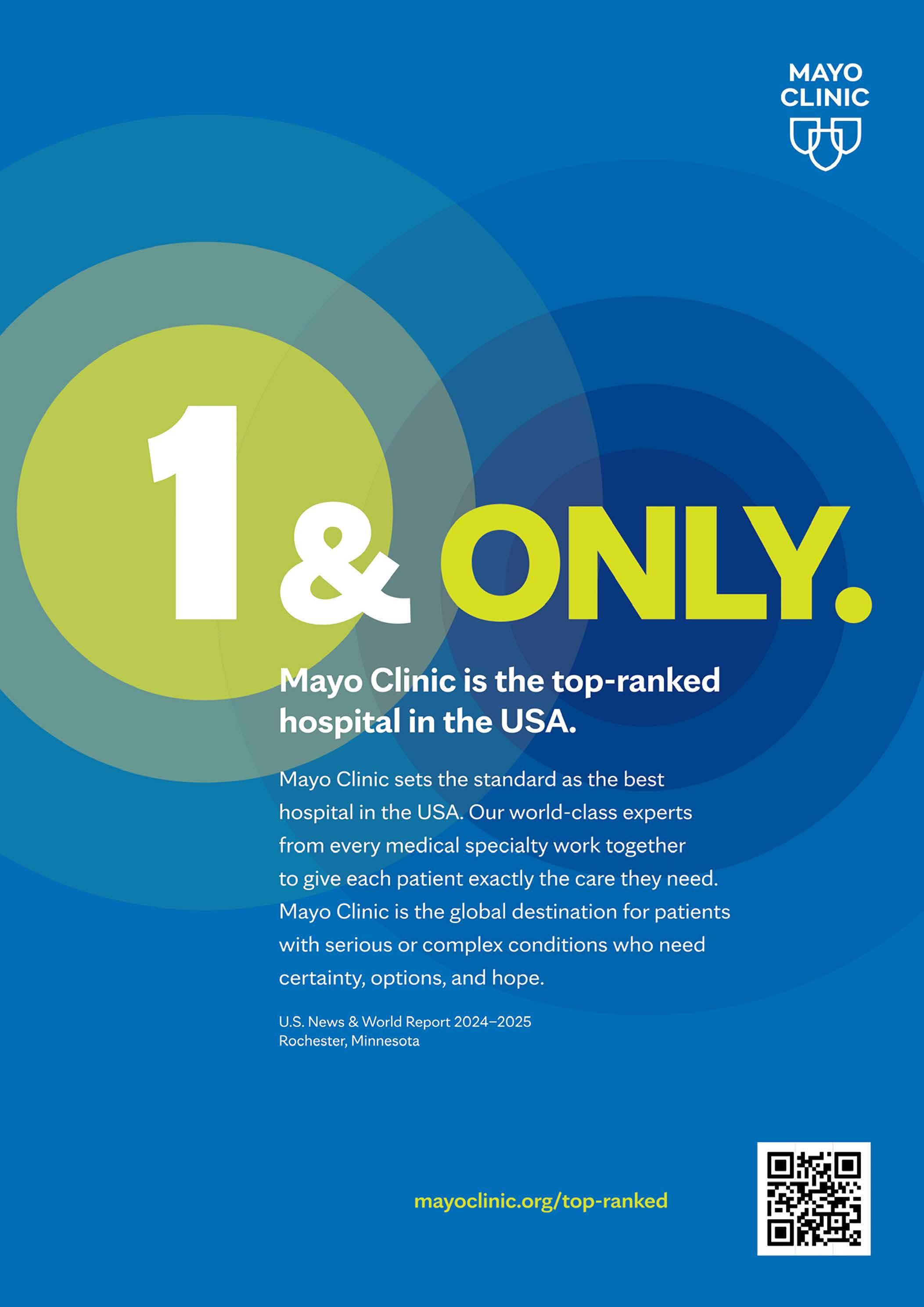Serving the region for over 40 years

September - October 2024

Serving the region for over 40 years

September - October 2024
Mesenchymal stem cells show promise for bone repair and regeneration

Neurology
New brain-computer interfaces restore speech in people who have lost ability to speak
Korea Health Industry Development Institute showcases innovative MedTech and BioTech companies
In the News
• Cleveland Clinic Abu Dhabi and NYU Abu Dhabi collaborate on 3D-printed heart model for rare cardiovascular case
• KFSHRC surgeons perform groundbreaking in utero endoscopic surgery to correct spinal defect
• Obesity in children linked to higher risk of immune-mediated skin diseases
• New blood test promises rapid and accurate diagnosis of ALS
• WHO and MPP launch initiative to advance mRNA vaccine development for H5N1 Influenza

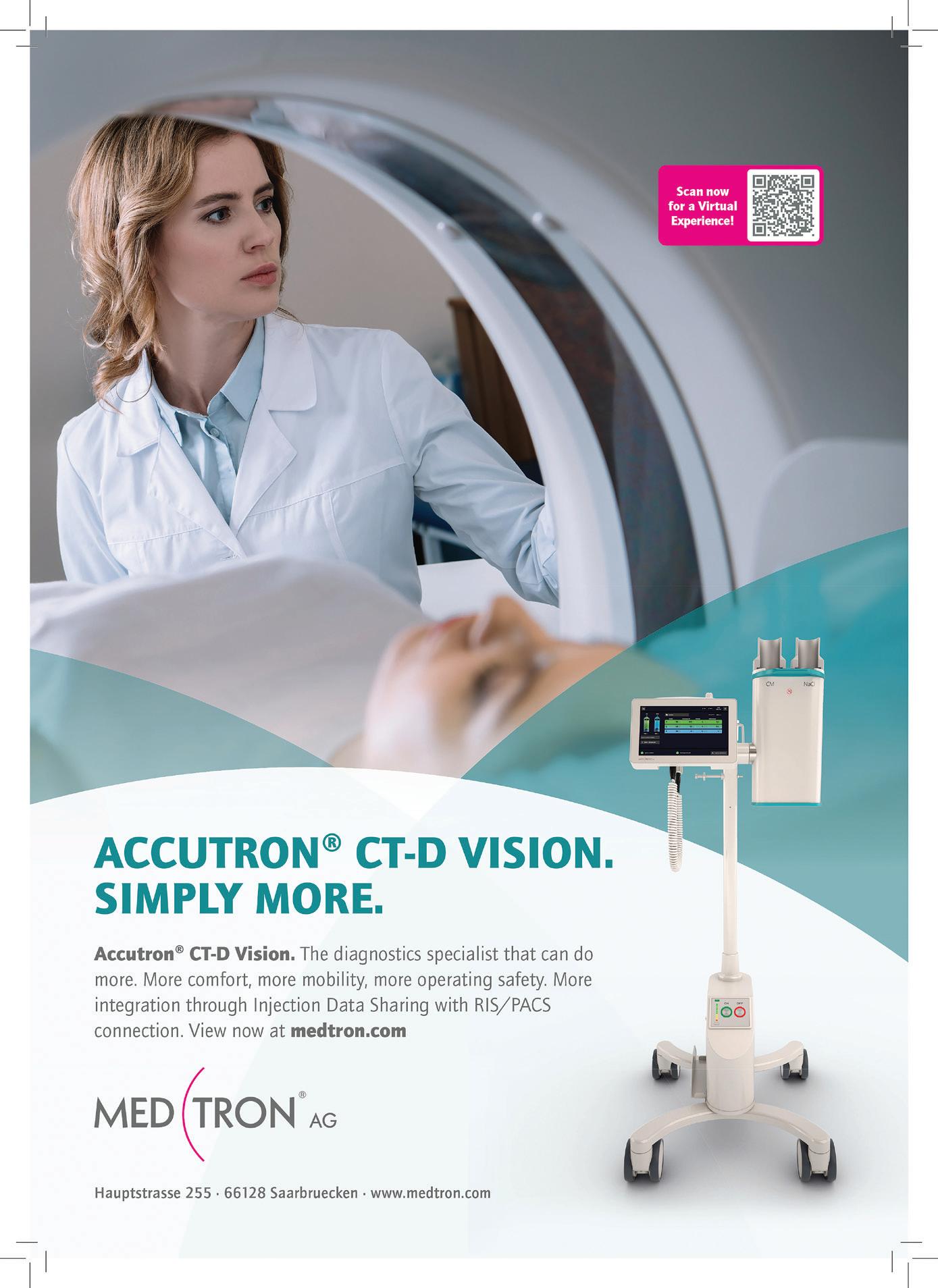
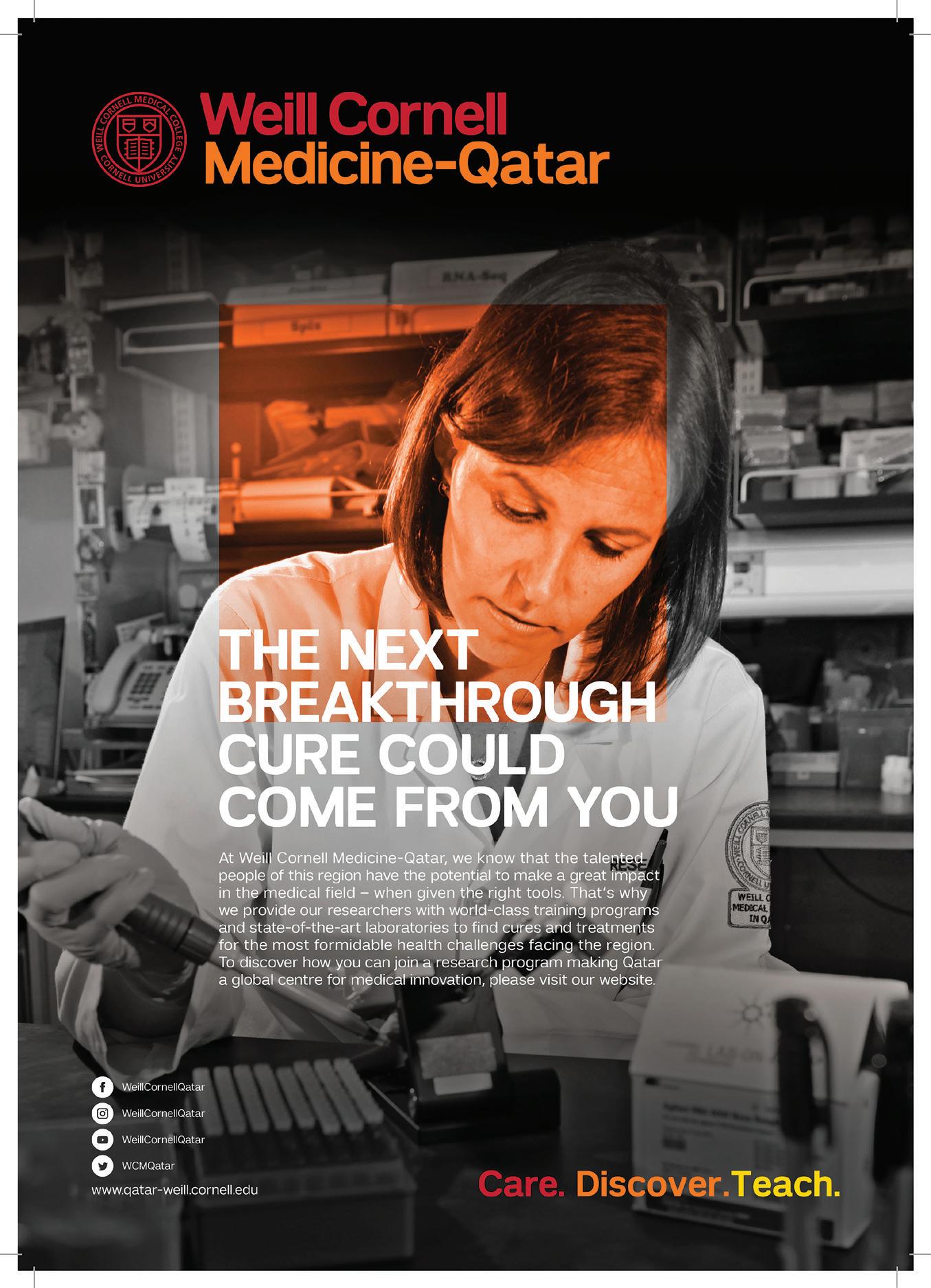

Recent advancements in orthopaedics and sports medicine are offering new ways for treating bone and joint disorders. In this issue we highlight several significant developments in regenerative therapies that may reshape treatment approaches in the near future.
Mesenchymal stem cells (MSCs) are demonstrating considerable potential for enhancing bone repair across various orthopaedic conditions. From acute fracture healing to managing recalcitrant nonunions and substantial bone defects, MSC-based therapies show promise in speeding up recovery and improving outcomes. Particularly noteworthy are the encouraging results observed in early-stage avascular necrosis of the femoral head, where MSC treatments may impede disease progression and potentially obviate the need for total hip arthroplasty.
Of equal interest is the development of a novel biomaterial by Northwestern University researchers that has successfully regenerated high-quality cartilage in an ovine model. This innovation could present new possibilities for addressing articular cartilage damage, degenerative joint diseases, and sports-related injuries. The material’s capacity to induce the formation of hyaline cartilage, rather than the less durable fibrocartilage, is especially significant.
Looking ahead, we observe ambitious projects such as Columbia University’s NOVAJoint initiative, which aims to create a biocompatible knee joint replacement using biomaterials and human stem cells. With substantial funding from ARPA-H, this multidisciplinary team is working towards clinical trials within a five-year timeframe, potentially heralding a new phase in regenerative orthopaedics.
Whilst these advancements are promising, it is crucial to note that larger clinical trials are still required to establish efficacy and long-term safety. Nonetheless, the potential to improve patient outcomes and quality of life makes these developments particularly interesting to follow.
Callan Emery Editor editor@MiddleEastHealth.com

Publisher Michael Hurst Michael@MiddleEastHealth.com
Editor Callan Emery editor@MiddleEastHealth.com
Editorial Consultants Dr Gamal Hammad, Dr Peter Moore, Harry Brewer
Middle East Editorial Office PO Box 72280, Dubai, UAE Telephone: (+9714) 391 4775 editor@MiddleEastHealth.com
Marketing Manager Foehn Sarkar Telephone: (+9714) 391 4775 n Fax: (+9714) 391 4888 marketing@MiddleEastHealth.com
Subscription & Admin Manager Savita Kapoor Telephone: (+9714) 391 4775 n Fax: (+9714) 391 4888 Savita@MiddleEastHealth.com
Advertising Sales PO Box 72280, Dubai, UAE marketing@MiddleEastHealth.com
Americas, France
Joy Sarkar P O Box 72280, Building No.2 2nd Floor, Dubai Media City Dubai, United Arab Emirates Tel: +971 4 391 4775 Fax: +971 4 391 4888 Joy@MiddleEastHealth.com
Japan
Mr Katsuhiro Ishii
Ace Media Service Inc 12-6, 4-chome, Adachi-ku, Tokyo 121-0824, Japan Tel: +81-3-5691-3335 n Fax:+81-3-5691-3336 Email: amskatsu@dream.com
China
Miss Li Ying
Medic Time Development Ltd, Flat 1907, Tower A, Haisong Building, Tairan 9th Road, Futian District, Shenzhen, China 518048 Tel: +86-755-239 812 21 n Fax: +86-755-239 812 33 Email: medic8@medictime.com
Taiwan
Larry Wang
Olympia Global Co Ltd 7F, No.35, Sec 3, Shenyang Rd, Taichung Taiwan 40651 n P O Box: 46-283 Taichung Taiwan 40799 Tel: +886- (4)-22429845 n Fax:+886- (4)-23587689 Email: media.news@msa.hinet.net
Middle East Health is published by Hurst Advertising FZ LLC , Dubai Media City, License Number: 30309
UAE National Media Council - Approval Number: 2294781
Middle East Health online www.MiddleEastHealth.com

Middle East Health is printed by Atlas Printing Press. www.atlasgroupme.com
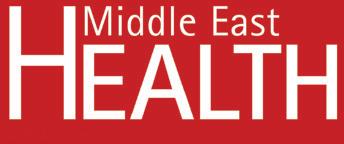

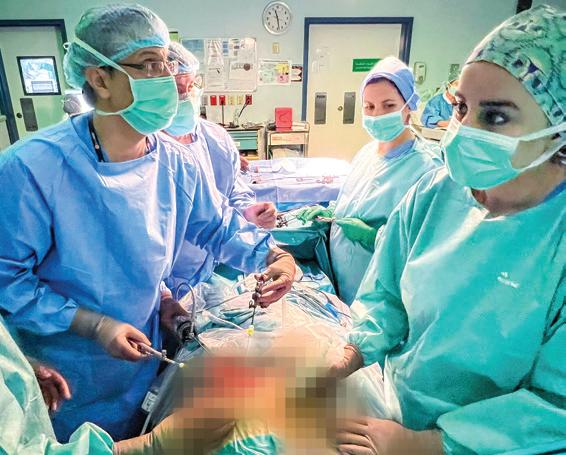
18 Orthopaedics & Sport Medicine: Mesenchymal stem cells show promise for bone repair and regeneration.
20 Orthopaedics & Sport Medicine: Breakthrough biomaterial shows promise for cartilage regeneration
21 Orthopaedics & Sport Medicine: Researchers awarded $39m to develop living knee replacement
26 Neurology: New brain-computer interfaces advance speech restoration
27 Neurology: Self-adjusting brain pacemaker shows promise for Parkinson’s symptom control
30 Neurology: Brain changes linked to obesity cause low sperm count, study finds
34 UK Report: ABHI UK Pavilion brings best of UK HealthTech innovation to the Middle East
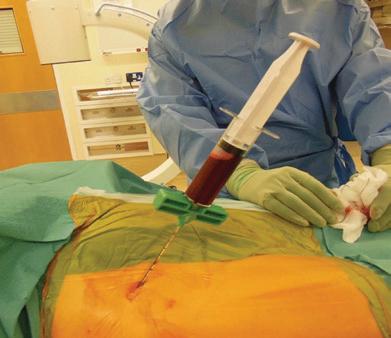
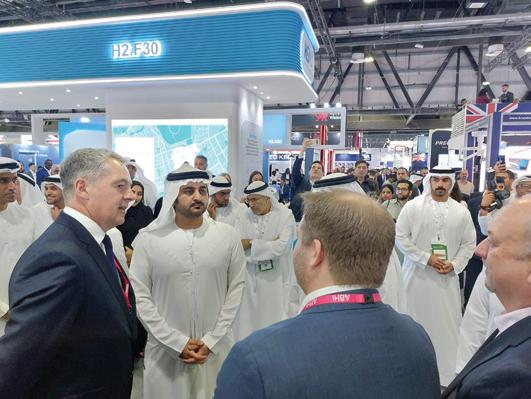
40 Mental Health: Arts and crafts: A prescription for mental wellbeing 41 Korea Health Industry Development Institute: A
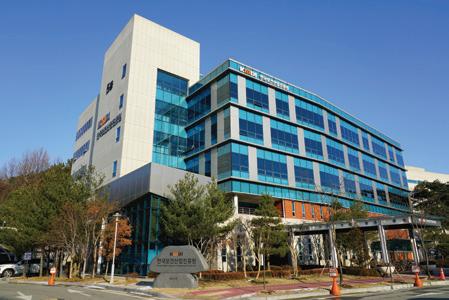


Cleveland Clinic Abu Dhabi and NYU Abu Dhabi collaborate
Innovative technology aids surgical planning for patient with Kommerell’s diverticulum and right-sided aortic arch.
In a groundbreaking collaboration, Cleveland Clinic Abu Dhabi and New York University Abu Dhabi have suc cessfully employed advanced 3D printing technology to create a precise model of a patient’s heart, facilitating the planning of a complex surgical intervention for a rare cardiovascular anomaly.
The case involved a 41-year-old pa tient, Mian Mohamed Shabbie, who presented with a congenital defect of the aorta. Specifically, Shabbie had a rightsided aortic arch accompanied by a giant aneurysm, a condition known as Kom merell’s diverticulum. This rare anatomi cal variation, occurring in only 0.03% of the global population, posed significant challenges for surgical intervention.
Technological innovation in surgical planning
The 3D printing technology, developed by NYU Abu Dhabi’s Core Technology Platform, involves a three-stage process: 3D image reconstruction, 3D slicing, and 3D printing. This approach allows for the creation of a physical replica of the patient’s anatomy, offering surgeons the opportunity to examine and simulate presurgical procedures with unprecedented accuracy.
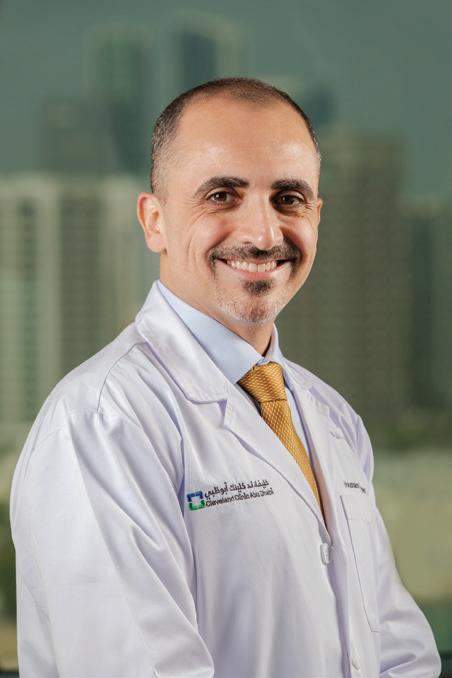
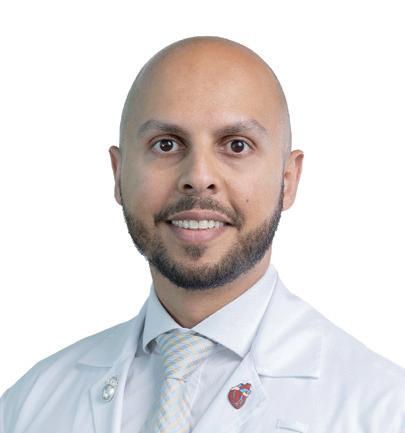
of this 3D printing technology extends beyond cardiac surgery. Researchers at Cleveland Clinic Abu Dhabi are exploring its use in various medical fields where complex anatomical structures are involved, including neurology.
Dr Houssam Younes, Department Chair for Vascular Surgery within the Heart, Vascular & Thoracic Institute at Cleveland Clinic Abu Dhabi, explained the rarity and complexity of the case: “Kommerell’s diverticulum is a rare cardiovascular abnormality, even more so when combined with a right-sided aortic arch. Due to its asymptomatic nature or presentation with symptoms commonly associated with other conditions, these congen-
Yazan Aljabery, Cardiac Surgeon at Cleveland Clinic Abu Dhabi, explained: “Correcting a case of Kommerell’s diverticulum when the aorta arches left, as is typical, is relatively straightforward because the deformity is accessible and visible. However, when the vessel arches right, as in this case, the defect is obscured by other large vessels, making surgical interventions particularly challenging. Using a 3D-printed model in such cases enhances the safety of the procedure and allows for more precise and tailored surgery.”
Broader applications
While this particular case focused on a cardiovascular application, the potential
The successful implementation of this technology aligns with Cleveland Clinic Abu Dhabi’s designation as a Centre of Excellence for Adult Cardiac Surgery by the Department of Health – Abu Dhabi. This recognition underscores the hospital’s commitment to providing comprehensive, integrated cardiac surgery and structural heart disease interventions.
This collaboration between Cleveland Clinic Abu Dhabi and NYU Abu Dhabi exemplifies the potential of interdisciplinary partnerships in advancing patient care. By leveraging cutting-edge technology, medical professionals can now approach complex cases with enhanced precision and confidence, potentially improving outcomes for patients with rare and challenging conditions.

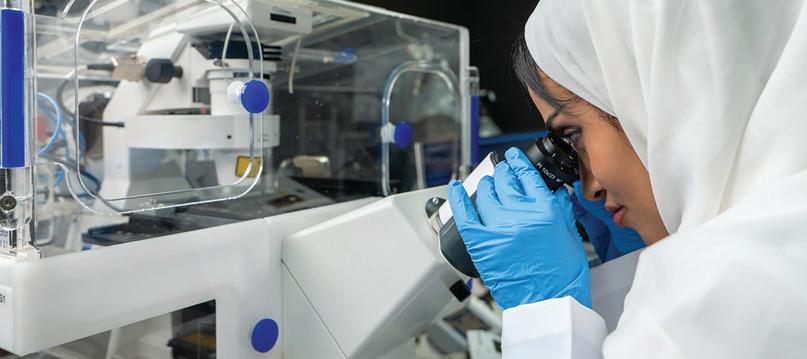
King Faisal Specialist Hospital & Research Centre (KFSHRC) in Riyadh, Saudi Arabia, is reinforcing its position as a leader in medical education and research through its Academic & Training Affairs (ATA) Department. The institution is offering a range of programmes designed to cultivate the next generation of healthcare leaders.
The King Faisal Aspiring Research Program, developed in collaboration with the Research and Innovation Centre and Al-Faisal University, stands out as a flagship initiative. This 12- to 18-month curriculum aims to equip trainees with advanced clinical research skills, guiding them through the entire research process. The programme’s efficacy is evident in the submission of over 60 research proposals to date.
Pioneering genomic medicine education
Set to launch in September 2024, the Ge-
nomic Track Program will offer specialised training in precision medicine. This intensive three-month course, comprising five key modules, targets residents and fellows with a keen interest in genomics. With a limited cohort of 10 trainees per course, the programme ensures focused, high-quality education in this rapidly evolving field.
KFSHRC’s educational initiatives dovetail with the burgeoning field of precision medicine, which is projected to reach a market value of US$144 billion by 2028. This growth is propelled by advances in genomics and personalised healthcare, enabling more targeted therapeutic approaches. Through its precision medicine and clinical research efforts, KFSHRC is positioning Saudi Arabia as a regional leader and contributing significantly to global advancements in these areas.
KFSHRC’s commitment to excellence has been recognised internationally. The institution has been ranked first in the Middle East and North Africa and 20th globally among the world’s top 250 Academic Medical Centres for the second consecutive year. It has also been acknowledged as the most valuable healthcare brand in Saudi Arabia and the Middle East, according to the 2024 Brand Finance rankings. Furthermore, Newsweek magazine has listed KFSHRC among the world’s best 250 hospitals in the same year.
By investing in these cutting-edge educational and research programmes, KFSHRC is not only preparing the next cohort of healthcare professionals but also solidifying its position as a global leader in medicine, both within Saudi Arabia and on the international stage.
Dubai Health has launched Blue Café, an innovative digital platform aimed at enhancing autism care for children. This initiative, which builds upon Dubai Health’s “Patients First” ethos, offers a comprehensive approach to support parents and caregivers of children with autism spectrum disorder (ASD).
Resources and research
The platform leverages Dubai Health’s expertise to provide evidence-based learning resources and fund autism care research. Developed by learning experts within Dubai Health, the content covers a wide range of autism care topics, delivered in a microlearning format to accommodate the busy schedules of families managing ASD.
Professor Nabil Zary, Senior Director
of the Institute of Learning at Mohammed Bin Rashid University of Medicine in Health Sciences, explained the initiative’s origins: “Blue Cafe was born from a desire to support the well-being of children with autism. We are proud to launch this first-of-its-kind living lab, combining the power of research with real-world experiences from the community.”
Community engagement
Recognising the potential isolation faced by families following an ASD diagnosis, Blue Café offers an interactive online forum. This virtual space allows parents and caregivers to connect, share experiences, and learn from one another, fostering a supportive community.
The platform will also host webinars, translating the latest research findings into practical care strategies for families.
This approach aims to bridge the gap between academic research and realworld application in autism care.
In the coming months, Dubai Health plans to open a physical Blue Café in Dubai. This space will serve as a gathering point for families and caregivers, with all proceeds directly funding research initiatives dedicated to improving autism care.
The initiative’s name and colour scheme align with the global recognition of World Autism Awareness Day, with blue symbolising calmness, understanding, and stability in the context of autism awareness.
• Medical professionals and interested parties can access the online learning resources and community forum at: www.bluecafedxb.org

King Faisal Specialist Hospital & Research Centre (KFSHRC) in Riyadh has achieved a significant milestone in foetal medicine by successfully performing the Middle East’s first in utero endoscopic surgery to correct a congenital spinal defect in a 26-week-old foetus. The procedure, which marks a notable advancement in prenatal interventions for spina bifida, was carried out using minimally invasive techniques.
The surgical team employed a foetal endoscope to create three small incisions, each measuring no more than 2 millimetres, in the uterus at the site of the foetus’s back. Throughout the procedure, continuous ultrasound monitoring was utilised to guide the surgeons. The congenital defect was successfully repaired, ensuring complete protection of the spinal cord.
Dr Saud Alshanafey, Director of the Foetal Diagnosis and Therapy Program and lead surgeon, explained the significance of this approach: “The novelty of this proce-
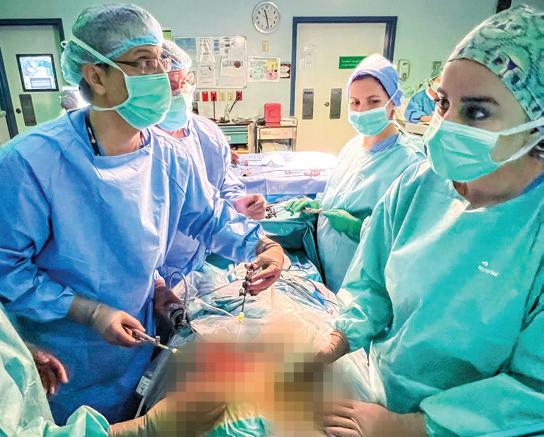
dure lies in repairing the congenital defect using a minimally invasive foetal endoscope through incisions no larger than 2 millimetres, avoiding the need to open the uterus, which positively impacts the health of the mother and the pregnancy.”
Traditionally, spina bifida is addressed through postnatal surgery to prevent infections in the nervous system. However, this method may not fully prevent neurological complications arising from the exposure of the spinal cord during pregnancy. The in utero intervention aims to enhance the baby’s future health and development while reducing the likelihood of complex surgeries after birth.
Spina bifida affects 1 in every 1,000 to 2,000 births globally. The condition results from incomplete closure of the neural tube during early foetal development, leading to exposure of the spinal cord to amniotic fluid. This exposure can affect the nerves
of the lower limbs, bladder, and lower digestive system, potentially accompanied by hydrocephalus. Consequently, patients may experience movement disorders, neurological dysfunctions, and urinary issues.
This pioneering procedure represents a significant advancement in foetal surgery and highlights KFSHRC’s commitment to providing cutting-edge healthcare. Dr Alshanafey said: “This achievement reflects significant medical advancements in foetal surgery and highlights KFSHRC’s commitment to providing the highest standards of healthcare to improve the quality of life for foetuses and their families in the Kingdom and beyond.”
The success of this procedure opens new avenues for prenatal interventions in the Middle East, potentially improving outcomes for foetuses diagnosed with spina bifida and other congenital defects amenable to in utero correction.
Cleveland Clinic Abu Dhabi, part of the M42 group, has successfully conducted the United Arab Emirates’ first stereoelectroencephalography (SEEG) procedure, marking a significant advancement in epilepsy treatment within the region.
SEEG is a minimally invasive surgical technique that precisely identifies the origins of intractable focal epileptic seizures within the brain. This procedure is particularly crucial for the 30% of epilepsy patients who do not respond adequately to medication and may require surgical intervention.
The pioneering SEEG was performed on an Emirati patient who had been suffering from epilepsy for over a decade. The complex surgery, which lasted several hours, was preceded by extensive multidisciplinary discussions and meticulous planning.
Post-procedure, the patient was monitored in the Epilepsy Monitoring Unit for 10
days with implanted leads in situ. During this period, spontaneous seizures were captured and localised to a specific brain region. Additionally, electric current was administered through the implanted leads to trigger the patient’s specific seizures, further corroborating the localisation of the epileptogenic zone.
Dr Florian Roser, Institute Chair of the Neurological Institute at Cleveland Clinic Abu Dhabi, who led the team, explained the procedure’s necessity: “If we cannot localise seizures with standard scalp EEG recording or other non-invasive imaging modalities, such as MRI, PET-CT, and ictal SPECT scans, then SEEG is necessary.”
Multidisciplinary approach
Dr Eugene Achi, Staff Physician in Neurology at the institute, emphasised the importance of early surgical intervention, citing studies showing improved outcomes in memory, quality of
life, and overall success rates of up to 70%.
Dr Achi highlighted the collaborative nature of the procedure, acknowledging contributions from epileptologists, neurosurgeons, neuropsychologists, neuroradiologists, and nuclear medicine radiologists.
The successful completion of the UAE’s first SEEG procedure represents a significant milestone in the country’s medical advancements. It offers new hope to patients with refractory epilepsy, providing benefits such as reduced complications, less postoperative pain, and quicker recovery.
As the first Level 4 Epilepsy Centre in the UAE, Cleveland Clinic Abu Dhabi’s Neurological Institute continues to provide complex neurodiagnostic monitoring and sophisticated imaging modalities, enabling comprehensive epilepsy surgical evaluation and treatment for patients with intractable epilepsy.

Imperial College
London Diabetes Centre showcases research leadership with multiple publications
The Imperial College London Dia betes Centre (ICLDC), a part of the M42 group, has demonstrated its leadership in diabetes research with nine studies published in high-impact peer-reviewed journals in 2024. These publications, appearing in respected outlets such as the nal of Obesity
Metabolism novel treatments and diabetes man agement strategies.
Innovative research findings
Among the notable outcomes, ICLDC re searchers have identified a potential new biomarker for predicting Type 2 diabetes and its associated complications. The centre’s studies have also evaluated the efficacy of emerging treatments, includ ing Tirzepatide (Mounjaro) and Inclisiran (Leqvio), contributing to the advance ment of diabetes therapeutics.
Furthermore, the research has es tablished new approaches for digitalbased diabetes education, specifically tailored for individuals observing Ra madan fasting. This work addresses the unique challenges faced by diabetic patients during religious fasting peri ods, an area of particular relevance in the UAE context.
Recognition as an active research site
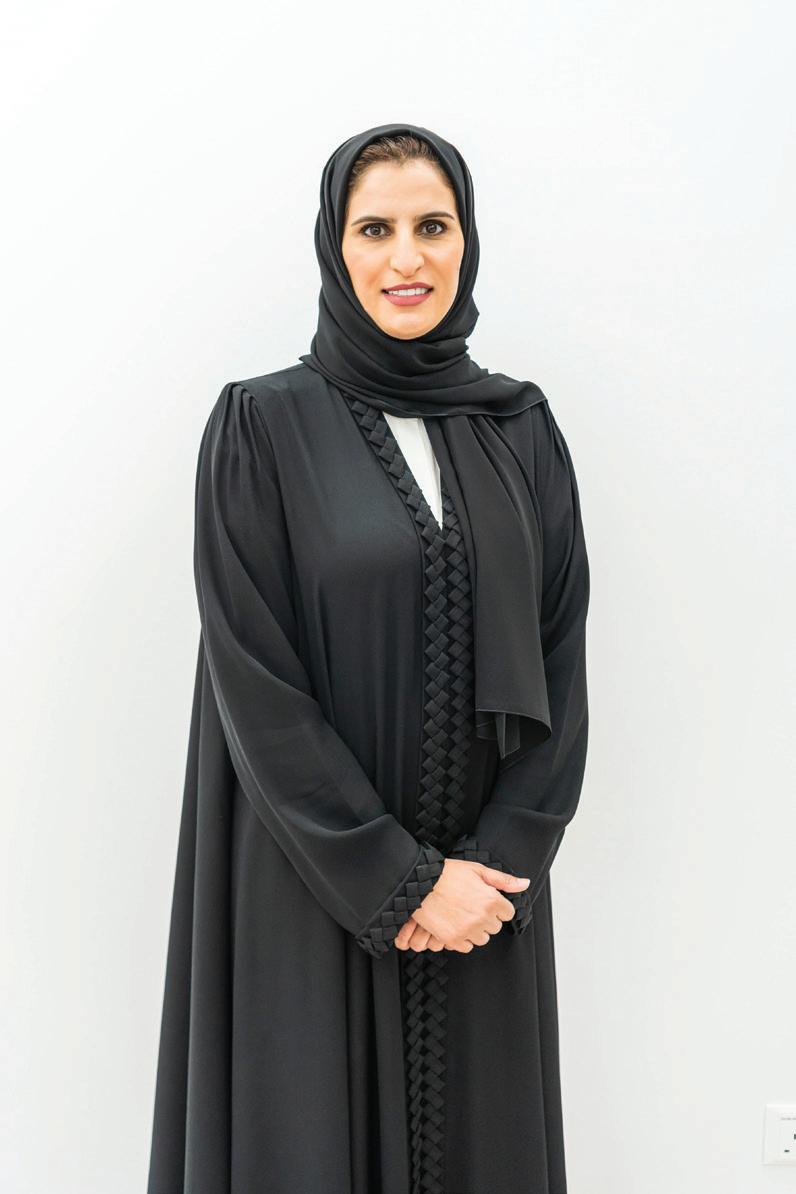

Our ability to build successful relationships with both international and local partners, including the National Heart Centre Singapore and the contract research organisation, RAY, have been crucial in this success.
diabetes causes, risks, and the importance of early detection. By combining cutting-edge research with public health initiatives, ICLDC aims to combat this complex disease and enhance community well-being.
The Department of Health – Abu Dhabi (DoH) has officially designated ICLDC as an “Active Research Site”, acknowledging its high rate of scientific publications. This prestigious recognition, awarded to only three organisations, underscores ICLDC’s performance, ICLDC was asked to double its target, highlighting its significant contribution to global diabetes research.
As ICLDC continues to expand its research portfolio, the centre remains dedicated to increasing awareness about
The centre’s multifaceted approach to diabetes care, research, and education positions it as a key player in addressing the hi gh prevalence of diabetes in the UAE and contributing to the broader global effort to improve diabetes management and outcomes.
New research reveals that obese children are more susceptible to developing common immune-mediated skin conditions, including atopic dermatitis, psoriasis, and alopecia areata.
A large-scale study conducted in South Korea has uncovered a significant association between childhood obesity and the development of immune-mediated skin diseases (IMSDs). The research, published in the September 2024 issue of the Journal of Investigative Dermatology, suggests that maintaining a healthy weight during childhood could potentially reduce the risk of these conditions.
The study, led by researchers from Seoul National University College of Medicine, analysed data from 2,161,900 Korean children over an 11-year period from 2009 to 2020. This comprehensive dataset allowed the team to investigate the relationship between obesity, dynamic changes in body weight, and the subsequent development of IMSDs.
Dr Seong Rae Kim, co-lead investigator from the Department of Dermatology at Seoul National University College of Medicine, explained the rationale behind the study: “Previously, many studies have looked at the link between childhood obesity and IMSDs. However, most of these studies only looked at data from one point in time or compared groups with and without the condition (i.e., obesity or overweight), and they had small sample sizes.”
Dr Kim further noted that very few studies had followed children over an extended period to observe how body weight affects the development of these skin conditions. This gap in longitudinal research meant that the causal relationship between obesity and IMSDs, particularly atopic dermatitis and psoriasis, remained unclear.
The research revealed that obese children were more likely to develop common IMSDs compared to their normal-weight

peers. Among the three most prevalent IMSDs studied – alopecia areata, atopic dermatitis, and psoriasis – atopic dermatitis showed the most pronounced trend.
Interestingly, the study also examined the impact of weight changes on IMSD risk. Children who transitioned from a normal weight to an overweight status demonstrated a higher risk of developing atopic dermatitis compared to those who maintained a normal weight. Conversely, children who lost weight, moving from an overweight to a normal status, exhibited a lower risk of developing atopic dermatitis than those who remained overweight.
Dr Seong-Joon Koh, co-lead investigator from the Department of Internal Medicine and Liver Research Institute at Seoul National University College of Medicine, emphasised the practical implications of these findings: “Our findings support the importance of promoting weight maintenance among children who are already within the normal weight range because it may help reduce the risk of developing atopic dermatitis.”
Dr Koh further advocated for preventive measures, stating: “Prevention of excessive weight gain and purposeful weight loss, including adopting healthy diet strategies in children with obesity to prevent atopic dermatitis, particularly before school age, should be promoted.”
The research team’s interest extends beyond the direct relationship between obesity and IMSDs. Dr Hyunsun Park, co-lead investigator from multiple departments at
Seoul National University, including the Laboratory of Intestinal Mucosa and Skin Immunology, highlighted their broader research focus: “Our research team is very interested in the skin-gut axis. We think that various factors, including diet, obesity, or other lifestyles can affect gut environment and contribute to the development of IMSDs.”
Dr Park views this study as a crucial step towards deciphering the relationship between environmental factors and immunemediated skin conditions. The team’s ongoing efforts aim to piece together the puzzle of how diet, obesity, and lifestyle factors may influence the gut environment and, subsequently, the development of IMSDs.
The findings of this study are particularly relevant given the global rise in childhood obesity rates. As childhood obesity continues to present a significant public health challenge, understanding its relationship with IMSDs becomes increasingly important.
The research underscores the potential for weight management strategies to play a role in reducing the incidence of IMSDs, particularly atopic dermatitis, in children. By promoting healthy weight maintenance and addressing obesity in young populations, healthcare providers may be able to mitigate the risk of these challenging skin conditions.
Reference:
1. Kim, S. R., Koh, S. J., Park, H. et. al. (2024). Childhood Obesity, Weight Change, and Pediatric Immune-Mediated Skin Diseases. Journal of Investigative Dermatology, 144(9). https://doi.org/10.1016/j.jid.2024.01.037

Researchers have developed a highly accurate blood test for amyotrophic lateral sclerosis (ALS), potentially reducing diagnosis times and improving patient outcomes.
A groundbreaking blood test for the diagnosis of amyotrophic lateral sclerosis (ALS) has been developed by researchers at the Brain Chemistry Labs in Jackson Hole, Wyoming. The test, which boasts an impressive 98% accuracy rate, could significantly reduce the time required for diagnosis and enable earlier treatment interventions for patients with this devastating neurodegenerative disease.
Current diagnostic challenges
ALS, a progressive condition affecting neurons in the brain and spinal cord, leads to gradual paralysis and eventual loss of motor function. At present, diagnosing ALS relies heavily on clinical examinations, a process that can take up to 12 months to yield definitive results. This prolonged diagnostic period often means that patients experience significant deterioration before receiving a confirmed diagnosis.
Moreover, the current diagnostic approach is prone to errors, with misdiagnosis rates reported to be as high as 68% in some cases. These factors combined have long presented a significant hurdle in providing timely and appropriate care for ALS patients.
The new diagnostic approach
The newly developed test, detailed in a study published on 13 September 2024 in the journal Brain Communications, [1] represents a potential paradigm shift in ALS diagnosis. It requires only a simple blood draw and relies on the analysis of microRNA sequences extracted
from tiny vesicles released by the brain and nervous system.
By examining hundreds of patient samples, the research team identified a unique “ALS fingerprint” comprising eight distinct microRNA sequences. This fingerprint allows for sensitive and specific differentiation between blood samples from ALS patients and those from healthy controls or individuals with conditions that mimic early-stage ALS.
The high accuracy and simplicity of this new test could have far-reaching implications for ALS patient care. Dr Sandra Banack, senior author of the study and scientist at Brain Chemistry Labs, remarked: “Rapid diagnosis will allow treatment to begin earlier leading to better outcomes for ALS patients.”
By potentially reducing diagnosis times from months to a matter of days, the test could enable earlier interventions and more effective management of the disease progression. This could prove crucial in a condition where time is of the essence, and where early treatment initiation can significantly impact patient outcomes.
The development of this diagnostic test is not based on a single study but is supported by three prior validation studies using different patient cohorts. In total, the research encompassed a sample size of 471, with many samples provided by the USA National ALS Biorepository. This extensive validation process lends substantial credibility to the test’s efficacy and reliability.
Dr Paul Alan Cox, Executive Direc-
tor of Brain Chemistry Labs, has expressed hope that the test will become widely available to neurologists within the next 18 to 24 months. To achieve this goal, the organisation is seeking to secure a partnership with a diagnostic company.
treatment
While the primary focus of this development is on improving diagnostic accuracy and speed, the implications of this test could extend beyond individual patient care. A more reliable and rapid diagnostic tool could potentially accelerate ALS research by enabling earlier identification of suitable participants for clinical trials.
Furthermore, the ability to diagnose ALS more quickly and accurately could provide researchers with valuable data on the early stages of the disease, potentially leading to new insights into its progression and underlying mechanisms.
While the results of this study are undoubtedly promising, it is important to approach them with measured optimism. As with any new diagnostic tool, further large-scale studies in diverse clinical settings will be necessary to fully validate its effectiveness and reliability in real-world scenarios.
Reference: 1. Banack, S., et al. (2024). A microRNA diagnostic biomarker for amyotrophic lateral sclerosis. Brain Communications. https://doi.org/10.1093/braincomms/fcae268

Despite significant advancements in reducing HIV infections and AIDS-related deaths among children, a new report highlights the urgent need for accelerated HIV services in countries most affected by the pandemic.
The Global Alliance for Ending AIDS in Children by 2030 has released a report titled “Transforming Vision into Reality”, which reveals both progress and persistent challenges in the fight against paediatric HIV/AIDS. Whilst programmes targeting vertical transmission have averted 4 million infections among children aged 0-14 years since 2000, the pace of progress has slowed in recent years, jeopardising the goal of ending AIDS in children by 2030.
Several countries within the Global Alliance have achieved notable success in providing lifelong antiretroviral therapy to pregnant and breastfeeding women living with HIV. Uganda has nearly reached 100% coverage, followed closely by the United Republic of Tanzania at 98% and South Africa at 97%. Other countries with high coverage rates include Mozambique (90%), Zambia (90%), Angola (89%), Kenya (89%), Zimbabwe (88%), and Cote d’Ivoire (84%).
UNAIDS Executive Director Winnie Byanyima praised these achievements, saying: “With the medicines and science available today, we can ensure that all babies are born – and remain – HIV-free, and that all children who are living with HIV get on and stay on treatment.”
Persistent challenges and widening gaps
Despite these advancements, the report highlights several areas of concern. In 2023, approximately 120,000 children aged 0-14 years were newly infected with HIV globally, with 77,000 of these infections occurring in Global Alliance
countries. Additionally, 76,000 AIDSrelated deaths were recorded among children in the same age group, with Global Alliance countries accounting for 49,000 of these deaths.
The treatment gap between adults and children continues to widen, with only 57% of children living with HIV receiving life-saving treatment compared to 77% of adults.

Vertical transmission remains a concern Vertical transmission rates remain alarmingly high in some regions, particularly in Western and Central Africa. Countries such as Nigeria and the Democratic Republic of the Congo have reported rates exceeding 20%, highlighting the need for targeted interventions in these areas.
The report also emphasises the critical role of addressing gender inequalities and human rights violations in the fight against paediatric HIV/AIDS. In 2023, there were 210,000 new infections globally among young women and girls aged 15-24 years, with 130,000 occurring in Global Alliance countries. This figure is four times higher than the 2025 goal of 50,000 new infections.
Nearly one in three women globally have experienced some form of violence during their lifetime, with adolescent girls and young women disproportionately af-
fected by intimate partner violence. These factors increase women’s vulnerability to HIV and hinder their access to essential services.
The Global Alliance for Ending AIDS in Children by 2030, launched in 2022 by WHO, UNICEF, and UNAIDS, has expanded to include civil society movements, national governments, and international partners such as PEPFAR and the Global Fund. Twelve countries are currently members of the alliance: Angola, Cameroon, Côte d’Ivoire, Democratic Republic of the Congo (DRC), Kenya, Mozambique, Nigeria, South Africa, United Republic of Tanzania, Uganda, Zambia, and Zimbabwe.
Reference:
World Health Organization. (2024). Transforming Vision into Reality. WHO Publications. https://www.who.int/publications/m/item/ transforming-vision-into-reality

Argentinian manufacturer Sinergium Biotech to lead efforts in developing mRNA vaccine candidates for avian influenza, with the aim of sharing technology and expertise with other low- and middle-income countries.
The World Health Organization (WHO) and the Medicines Patent Pool (MPP) have announced a new project aimed at accelerating the development and accessibility of messenger RNA (mRNA) vaccine candidates for human avian influenza (H5N1). Launched on 29 July 2024, this initiative is part of the broader mRNA Technology Transfer Programme, which seeks to build capacity in low- and middle-income countries (LMICs) for the development and production of mRNA-based vaccines.
Expanding global vaccine development capacity
The project will be spearheaded by Sinergium Biotech, an Argentinian manufacturer and partner in the mRNA Technology Transfer Programme. Sinergium Biotech has already developed candidate H5N1 vaccines and is working to establish proof-of-concept in preclinical models. Once the preclinical data package is complete, the technology, materials, and expertise will be shared with other manufacturing partners.
Dr Tedros Adhanom Ghebreyesus, WHO DirectorGeneral, emphasised the importance of this initiative:
“This initiative exemplifies why WHO established the mRNA Technology Transfer Programme – to foster greater research, development and production in lowand middle-income countries, so that when the next pandemic arrives, the world will be better prepared to mount a more effective and more equitable response.”
Avian influenza viruses pose a significant public health risk due to their widespread circulation in animals and potential to cause a future pandemic. This development complements ongoing work under the Pandemic Influenza Preparedness Framework, which aims to improve the sharing of influenza viruses with human pandemic potential and increase LMIC access to vaccines.
The project’s focus on H5N1 is particularly timely, given the recent increase in human cases of avian influenza and the virus’s potential for pandemic spread. By developing mRNA vaccine candidates for H5N1, the initiative aims to strengthen global preparedness for potential influenza pandemics.
Fostering collaboration and knowledge sharing
Charles Gore, Executive Director of MPP, highlighted the programme’s goals, saying: “When we created the mRNA Technology Transfer Programme with WHO, our goal was to enable low- and middle-income countries to lead development efforts, foster collaboration, share resources, and disseminate knowledge. This project embodies our vision and demonstrates a strong commitment to future pandemic preparedness and response.”
The initiative also underscores the importance of geographical diversification in health technology innovation and production. Dr Jarbas Barbosa, Director of the Pan American Health Organization, noted the significance of recognising capacities in Latin America and the Caribbean, as well as the importance of early planning for access and sharing of knowledge and technologies during research and development processes.
Since its inception, the mRNA Technology Transfer Programme has made significant progress in developing and implementing a platform for establishing the immunogenicity, efficacy, and safety of vaccine candidates in preclinical animal models. This platform, created and validated at Afrigen, is now being transferred to manufacturing partners for adaptation and enhancement for other critical disease targets.
Dr Alejandro Gil, Chief Executive Officer of Sinergium, expressed enthusiasm for the project, stating: “Sinergium’s enhanced capacity and readiness to apply our expertise to H5N1 will play a vital role in this effort towards global pandemic preparedness. We are excited to tackle this public health challenge and our R&D team will continue to work closely with the Programme Partners.”
As the project progresses, Sinergium Biotech will work on developing and refining H5N1 mRNA vaccine candidates, with the ultimate goal of sharing their findings and technology with other manufacturing partners in LMICs. This collaborative approach aims to accelerate the development of H5N1 vaccine candidates globally and strengthen pandemic preparedness efforts.

Middle East Health reports on a comprehensive review that highlights the potential of cellular therapies using mesenchymal stem cells to enhance bone healing across a range of orthopaedic conditions, although it is noted that larger clinical trials are still needed.
Mesenchymal stem cells (MSCs) play a crucial role in bone homeostasis and repair, providing both progenitor cells for bone formation and regulating the local environment to promote bone growth. A new narrative review published in the Journal of Orthopaedics and Traumatology [1] examines the current applications and future potential of MSC-based cellular therapies for enhancing bone healing in various orthopaedic conditions.
Current applications
The review, led by researchers at the University of Leeds, UK, explores how MSCs are being utilised to augment bone repair in several key areas:
Acute fracture healing
Some promising results have been seen with the use of MSCs in acute fracture care, particularly for challenging injuries. In one study, injecting culture-expanded MSCs into acute tibial fractures 3-6 weeks post-operatively reduced the time to union by nearly half compared to controls. Another trial found that injecting cultured osteoblastic cells derived from MSCs into various long bone fractures at 6-8 weeks post-fixation significantly accelerated radiological healing. However, not all fracture types have
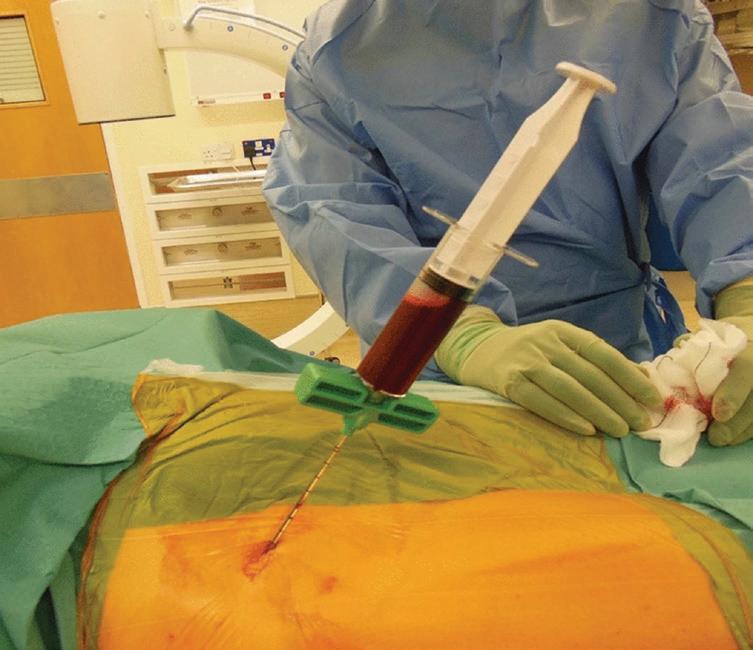
shown clear benefits. A study examining the injection of bone marrow aspirate during fixation of femoral neck fractures found no difference in nonunion rates or functional
outcomes compared to standard treatment. The authors note this may be due to the difficulty in controlling where the injected cells ultimately end up within the joint.
Fracture nonunion, where a fracture fails to heal within the expected timeframe, represents a complex challenge in orthopaedics. The review highlights several studies showing positive results using MSCs to enhance healing in nonunion cases.
One approach involves directly injecting bone marrow aspirate, which contains MSCs, into the nonunion site. A small study achieved union in 10 out of 12 patients with long bone nonunions using this technique. Other researchers have combined bone marrow aspirate with scaffolds like freeze-dried allograft to provide both cells and a structure to support new bone growth.
More involved techniques utilise cultureexpanded MSCs, which allows for a higher concentration of cells to be delivered. Studies have shown good results seeding these expanded cells onto various scaffolds like collagen microspheres or hydroxyapatite granules before implantation. Even when compared to the current gold standard of autologous bone grafting, some trials found faster and more reliable union using MSCbased approaches.
Large bone defects pose a significant reconstructive challenge. While the literature on MSC use for bone defects is more limited, some promising results have been reported. One study used culture-expanded MSCs combined with hydroxyapatite scaffolds to manage long bone defects averaging 5.25 cm in size, achieving consolidation in all four cases within 7 months.
The review authors note that cell therapies appear to provide particular benefit when combined with bone graft materials for defect reconstruction. However, they emphasise that larger studies are still needed in this area.
Avascular necrosis of the femoral head
Avascular necrosis (AVN) of the femoral head, where bone tissue dies due to lack of
blood supply, is another condition where MSC therapies show potential. If untreated, AVN often progresses to femoral head collapse requiring joint replacement. Several studies have examined using MSCs to regenerate bone and prevent this progression.
Approaches include injecting MSCs directly into the femoral artery supplying the hip, injecting them into the necrotic lesion itself, or applying them on scaffolds following core decompression of the femoral head. Many of these studies, particularly for early-stage disease, have shown good results in terms of preventing disease progression and avoiding the need for hip replacement.
One study comparing core decompression with and without bone marrow aspirate concentrate injection found significantly better outcomes with the addition of MSCs – only 15% required hip replacement at 3 years compared to 35% in the control group. Another trial combining MSCs with vascularised bone grafting for advanced AVN saw a hip replacement rate of just 16% at 5 years.
The way forward
While the results so far are encouraging, the review authors emphasise that the current literature remains heterogeneous, with most publications being small case series at high risk of bias. Larger, welldesigned clinical trials are still needed to definitively establish the efficacy of these approaches.
The ideal scenario of custom-engineered scaffolds seeded with patient-specific expanded MSCs remains labour intensive and costly for routine clinical use. In the meantime, combining expanded MSCs with autologous bone graft appears to be a clinically effective compromise, albeit at the cost of donor site morbidity from harvesting the bone graft.
Key areas for future research identified in the review include:
- Developing improved methods to purify and concentrate MSCs from bone mar-
row aspirate without requiring lengthy tissue culture expansion
- Identifying biocompatible scaffold materials that can better mimic the properties of native bone
- Optimising cell delivery methods to ensure MSCs reach and engraft at the intended site
- Determining the most effective timing and dosing of MSC therapies for different orthopaedic conditions
Challenges and limitations
The review highlights several challenges that still need to be overcome before MSC therapies can be widely adopted in routine orthopaedic practice:
Standardisation: There is significant variation between studies in terms of cell harvesting techniques, expansion protocols, and delivery methods. This makes it difficult to compare results across trials and determine optimal approaches.
Regulatory hurdles: Extensive culture expansion of cells is often classified as an advanced therapy medicinal product, requiring complex and costly regulatory approval processes.
Cost-effectiveness: While potentially offering improved outcomes, the additional costs of cell expansion and specialised scaffolds need to be weighed against current standard treatments.
Long-term safety: More data is needed on the long-term safety of these approaches, particularly regarding the potential for ectopic bone formation or other unintended effects of cell implantation.
Conclusion
The authors conclude that MSC-based cellular therapies show significant promise for enhancing bone repair across a range of orthopaedic conditions. However, they emphasise that further research is needed to optimise techniques, demonstrate clear clinical superiority over current treatments, and ensure long-term safety before these approaches can be widely adopted.
Reference: 1. Rodham, P., Khaliq, F., Giannoudis, V., et. al. (2024). Cellular therapies for bone repair: current insights. Journal of Orthopaedics and Traumatology, 25(28). https://doi.org/10.1186/s10195-024-00768-0
Northwestern University researchers have developed a novel biomaterial that successfully regenerated high-quality cartilage in a large-animal model, potentially offering a new approach to treating joint damage and osteoarthritis.
Scientists at Northwestern University have engineered a groundbreaking biomaterial that demonstrates remarkable efficacy in regenerating high-quality cartilage within knee joints of a large-animal model. This innovative material, which mimics the natural environment of cartilage in the body, could potentially revolutionise the treatment of joint damage, degenerative diseases like osteoarthritis, and sportsrelated injuries such as ACL tears.
The research, published in the Proceedings of the National Academy of Sciences [1] , represents a significant step forward in addressing the challenging problem of cartilage repair. Cartilage, a crucial component in joints, is notoriously difficult to regenerate in adult humans due to its limited inherent healing capacity.
Composition and mechanism of action
The newly developed biomaterial is a complex network of molecular components that work in concert to create an environment conducive to cartilage regeneration. It comprises two primary elements: a bioactive peptide that binds to transforming growth factor beta-1 (TGFβ-1), a protein essential for cartilage growth and maintenance, and modified hyaluronic acid, a natural polysaccharide found in cartilage and synovial fluid.
Professor Samuel I. Stupp, who led the study, explained the rationale behind using hyaluronic acid: “Many people are familiar with hyaluronic acid because it’s a popular ingredient in skincare products. It’s also naturally found in many tissues throughout
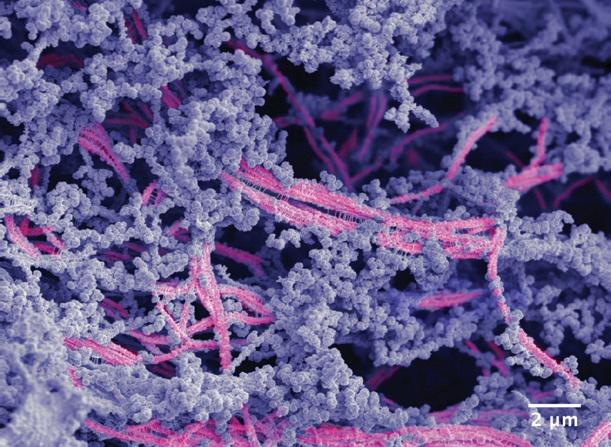
the human body, including the joints and brain. We chose it because it resembles the natural polymers found in cartilage.”
The researchers integrated the bioactive peptide and chemically modified hyaluronic acid particles to drive the self-organisation of nanoscale fibres into bundles that mimic the natural architecture of cartilage. This structure creates an attractive scaffold for the body’s own cells to populate and regenerate cartilage tissue, with the bioactive signals in the nanoscale fibres encouraging cartilage repair by the cells.
Promising results in animal model
To evaluate the material’s effectiveness, the research team tested it in sheep with cartilage defects in the stifle joint, which is analogous to the human knee. This choice of animal model is particularly significant, as Prof. Stupp noted: “A study on a sheep model is more predictive of how the treatment will work in humans. In other smaller animals, cartilage regeneration occurs much more readily.”
The researchers injected the thick, paste-like material into cartilage defects, where it transformed into a rubbery matrix. Within just six months, they observed evidence of enhanced repair, including the growth of new cartilage containing the natural biopolymers collagen II and proteoglycans, which are crucial for pain-free mechanical resilience in joints.
Importantly, the new cartilage growth not only filled the defect as the scaffold degraded but also consistently demonstrated higher quality compared to the control group.
This suggests that the biomaterial is capable of inducing the formation of hyaline cartilage, the type needed for functional joints, rather than the less desirable fibrocartilage often produced by current treatments.
The current standard of care for cartilage damage is microfracture surgery, during which surgeons create tiny fractures in the underlying bone to induce new cartilage growth. However, this approach often results in the formation of fibrocartilage, which is less resistant to wear and tear than hyaline cartilage.
Prof. Stupp envisions that the new biomaterial could be applied to joints during open-joint or arthroscopic surgeries. He explained: “By regenerating hyaline cartilage, our approach should be more resistant to wear and tear, fixing the problem of poor mobility and joint pain for the long term while also avoiding the need for joint reconstruction with large pieces of hardware.”
While the results are promising, further research will be necessary before this treatment can be translated to human patients. However, the potential implications of this breakthrough are significant. If successful in human trials, this biomaterial could potentially prevent the need for full knee replacement surgeries, offer new treatment options for degenerative diseases like osteoarthritis, and provide improved outcomes for sports-related injuries.
Reference:
1. Lewis, J., et al. (2024). A bioactive supramolecular and covalent polymer scaffold for cartilage repair in a sheep model. Proceedings of the National Academy of Sciences. https://doi.org/10.1073/pnas.2405454121
A team from Columbia University has received substantial funding from ARPA-H to create a revolutionary biocompatible knee joint replacement using biomaterials and human stem cells, aiming for clinical trials within five years.
The United States-based Advanced Research Projects Agency for Health (ARPAH) has awarded nearly US$39 million to a team of researchers from Columbia University Irving Medical Center (CUIMC) and Columbia Engineering to develop a living knee replacement. This project, dubbed NOVAJoint, aims to create a biocompatible, low-cost, patient-specific knee joint replacement using biomaterials and human stem cells, including the patient’s own cells.
Addressing the osteoarthritis challenge Osteoarthritis, the most common type of arthritis, affects millions of people worldwide and poses a significant burden on healthcare systems. The degenerative joint disease gradually worsens over time as cartilage wears down, leading to pain, stiffness, and reduced mobility. With an ageing population and increasing rates of obesity, the prevalence of knee osteoarthritis has been rising steadily.
Current treatment options for advanced osteoarthritis typically involve total knee replacement using prosthetic implants made of metal and plastic. While these procedures are generally successful, they come with potential complications and limitations, including infection, loosening, hardware failure, and persistent pain. Moreover, conventional knee replacements have a limited lifespan, often requiring revision surgeries after 15 to 20 years.
The NOVAJoint solution
The Columbia team’s NOVAJoint project aims to address these challenges by developing a living knee replacement composed

of regenerated cartilage and bone. This innovative approach is expected to integrate seamlessly with the patient’s native bone and restore pain-free joint function.
Professor Clark T. Hung, the project’s lead researcher, explained: “The ARPAH NITRO programme has enabled us to leverage our innovative technologies and expertise to solve one of the most difficult challenges in biomedical engineering.”
The team plans to create two versions of NOVAJoint: one using the patient’s own cells and another using donor cells. This dual approach aims to provide flexibility in treatment options while potentially extending implant life and reducing complications.
The NOVAJoint project brings together experts from various fields, including biomechanics, biomaterials, stem cells, and orthopaedic surgery. The multidisciplinary team spans several departments at Columbia University, including Biomedical Engineering, Mechanical Engineering, Orthopaedic Surgery, and Dental Medicine.
Key collaborators on the project include: Clark Hung, Professor of Biomedical Engineering and Orthopedic Sciences (in Orthopedic Surgery); Nadeen Chahine, Associate Professor of Biomedical Engineering (in Orthopedic Surgery); Treena Arinzeh, Professor of Biomedical Engineering; Gerard Ateshian, Andrew Walz Professor of Mechanical Engineering and Professor of Biomedical Engineering; Alice Huang, Associate Professor of Bioengineering (in Orthopedic Surgery) and; Roshan Shah, Russell A. Hibbs Associate Professor and
Director of Complex Reconstruction at Columbia University, among others.
The team is also partnering with external organisations such as the University of Missouri, New York Stem Cell Foundation, and New York Blood Center for preclinical testing and manufacturing.
The researchers have set an aggressive timeline for the project, aiming to create the first prototypes within two years before moving on to preclinical and clinical studies in the final three years. The team plans to conduct a Phase 1 safety clinical trial in the project’s final year.
Commenting on the project, Dr Nadeen O. Chahine, a leader in orthopaedic research and co-lead on the project, said: “NOVAJoint will mark a major milestone in the field of regenerative medicine and orthopaedic surgery, and has the potential to revolutionise musculoskeletal treatments of the many joints that degenerate with age or injury.”
Dr Shah, commented on the project’s potential impact: “Our goal is to push knee replacement to its next stage of evolution and to create a better solution to osteoarthritis. Every day patients ask me about new advancements in knee replacement surgery, hoping for validation of their years of suffering before seeking care. Now I have something to tell them.”
The success of this project could pave the way for similar advancements in the treatment of other degenerative joint conditions, potentially revolutionising the field of orthopaedic medicine.
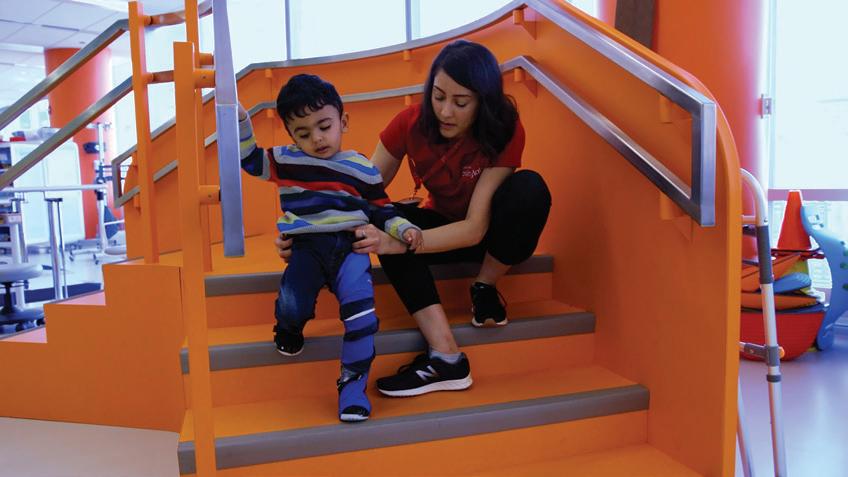
Born at just 25 weeks gestation, Matar was diagnosed with cerebral palsy, epilepsy and hydrocephalus, a condition that leads to excess fluid on the brain. His parents were told he wouldn’t survive.
Against all odds, Matar did survive. However, his family initially was met with more heartache when they were told by doctors that he would never be able to stand, walk or talk.
At the age of three, Matar traveled with his family from their home in the United Arab Emirates to the United States in hopes of finding the medical support he needed. That journey led them to Shirley Ryan AbilityLab in Chicago, Illinois, and offered a renewed sense of hope.
“Being away from home is very difficult,” said Othman, Matar’s father. “Yet, we were committed to sacrificing anything and doing whatever it took to find a cure for our son.”
When Matar arrived at Shirley Ryan AbilityLab, he was only capable of dragging his body across the floor and walking on his knees. He also could not speak and almost never used his left hand. As he received intensive speech, occupational and physical therapy during his six-month stay at the hospital, progress soon began to take form.
Destination: Ability Matar’s story is not unique. Thousands of
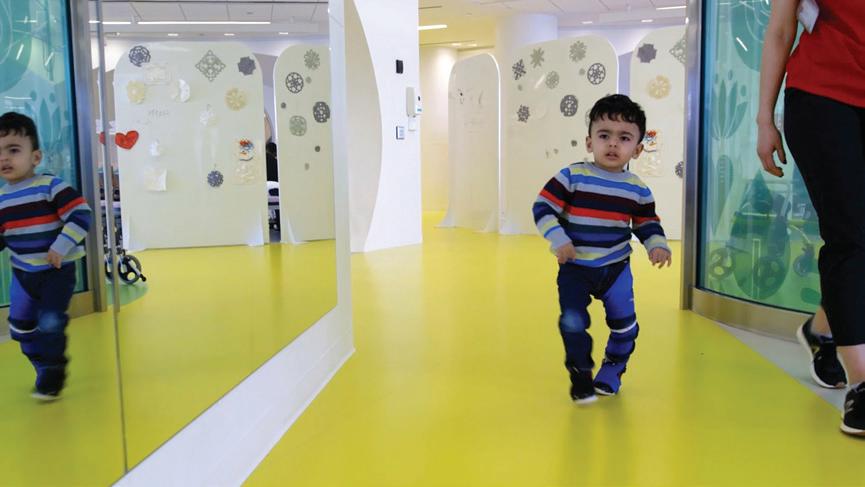
patients travel great distances to receive care from Shirley Ryan AbilityLab, the global leader in physical medicine and rehabilitation. The hospital serves adults and children with the most severe, complex conditions – from traumatic brain and spinal cord injury to stroke, amputation and cancer-related impairment.
Its reputation precedes it. In fact, Shirley Ryan AbilityLab has been designated the No. 1 rehabilitation hospital in America by U.S. News & World Report annually since 1991. Each year, patients come from around the world to Shirley Ryan AbilityLab’s state-of-the-art research hospital in Chicago. There, clinicians and scientists embrace a translational approach that integrates the latest research findings into care. This unique model enables patients to benefit from access to the brightest minds, the latest research and the best opportunity for recovery.
Curated, comprehensive offerings for global patients
For those coming from afar, the Shirley Ryan AbilityLab Global Patient Services (GPS) team members work with patients and their families before, during and after their care process. Beyond coordinating international travel arrangements, GPS case managers also collaborate with numerous third parties, including working with embassies on every-
thing from visas to patient sponsorship.
Additionally, the team manages logistics for transporting patients with physical impairments and other medical needs. GPS case managers link patients and families with service partners who provide a range of resources – interpreting and translation, exchange of medical records, setting up bank accounts and handling other financial matters, obtaining a mobile telephone and cellular service, securing housing, and more.
“Like family”
By the time of his discharge, Matar was walking, talking and using his left hand as he continued to make strides in his recovery.
“Shirley Ryan AbilityLab is so different from any other rehabilitation facility we have ever seen – not only in terms of having the latest technology and the biggest building but, most importantly, because it has the greatest people,” said Othman.
“The therapists there are like family. From day one, we felt that they genuinely care about their patients. They are truly amazing, and they make miracles happen every day.”
Connect with Shirley Ryan AbilityLab
Interested in learning more about Shirley Ryan AbilityLab’s best-in-class care?
Visit http://sralab.org/international
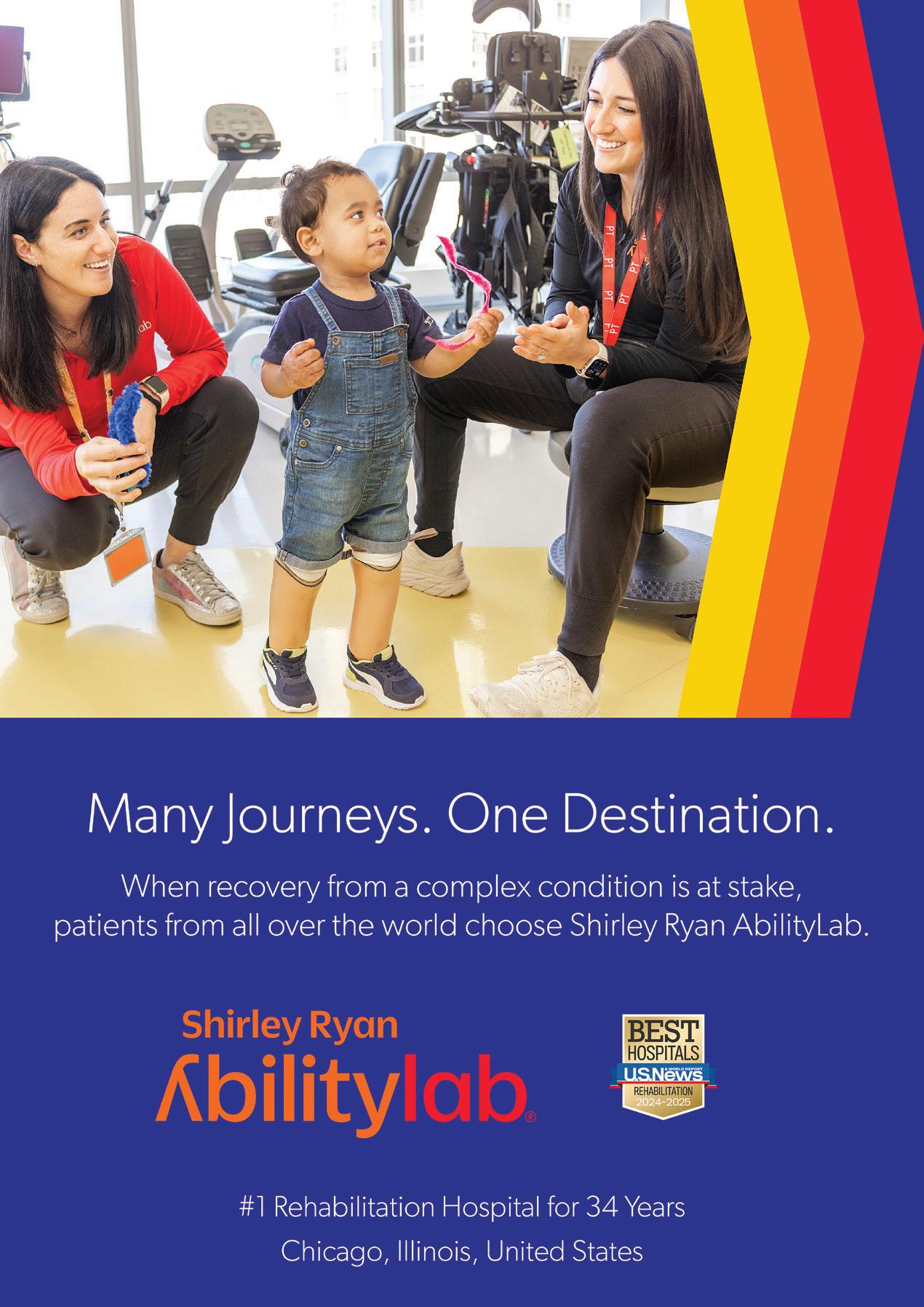
Technogym, the world leader in fitness and wellness solutions, is excited to announce an exclusive two-day regional education summit, set to take place on September 10th at The Bridge Lifestyle Hub in Abu Dhabi and on September 11th at the Siro Hotel in Dubai.
The workshops are accredited and aim to bring together top industry experts, coaches, medical professionals, and trainers from around the globe to share cuttingedge knowledge and innovative practices in sport, health, and fitness.
Created by industry-leading experts from the United States of America, Australia, GCC and UK, it allows for valuable insights into cutting-edge assessments and training approaches for general populations alongside elite level athletes.
The Sport Education pathway will allow for development and learning from industry experts who coach elite professional athletes across the globe. An enhancement in skills and assessing both general population and elite level athletes before applying advanced principles of programming that have been tested on the world’s top athletes.
The Health Education pathway focuses on cardiorespiratory testing for general population and athletes using gas analysis. As-


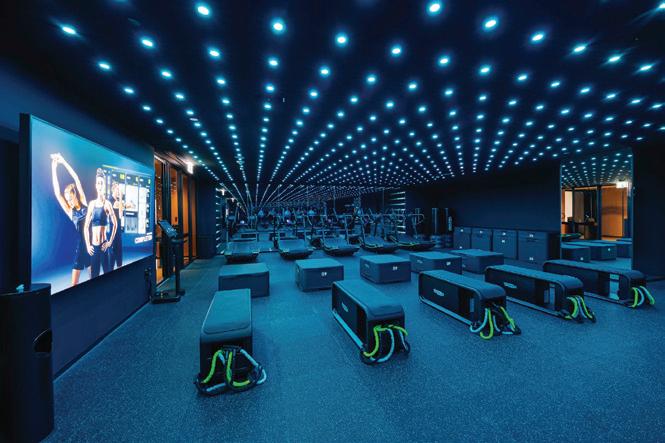
sessing and programming for longevity as well as synergy of wellness which explores metabolic testing and food intolerances.
The Fitness Education pathway has been
designed to enhance the assessment tools of trainers and coaches to cover six unique pillars before exploring programming methods, that will deliver long term sustainable results for individuals and groups.
Starting from the analysis of your physical and functional conditions, the innovative AI-based assessment station calculates your Wellness Age and automatically prescribes your ideal training protocol, that adapts over time.
Numerous scientific studies demonstrate that regular physical exercise and a healthy lifestyle are key elements in achieving healthy longevity, meaning living longer in good health. Regular physical exercise is a powerful medicine, but it requires pre cise dosage. Technogym can prescribe the ideal training protocol for you thanks to artificial intelligence and the analysis of your physical parameters.
The new Technogym Checkup – the in novative AI-based assessment station – tar gets your training depending on your physical and functional parameters and, by leveraging artificial intelligence, it obtains the prescrip tion of a precision program tailored to your needs, goals, and condition.
After logging in with the Technogym App, Technogym Checkup will measure your body composition, strength, balance, mobility, and cognitive abilities through precise and reliable tests. The data collected with Technogym Checkup, available within the Technogym Ecosystem, will be processed by Technogym AI Coach – Technogym’s AI digital trainer –and transformed into a personalized training protocol, based on real data which is always at your fingertips, ensuring a precision training experience.
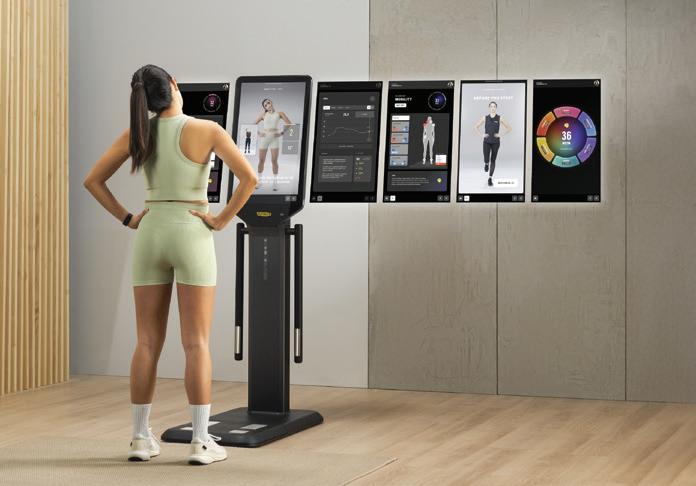
For industry operators, Technogym Checkup represents a great opportunity to offer their members an innovative, unique, personalized service capable of ensuring a frictionless training experience – from the first access and program configuration, to
Thanks to the Technogym Ecosystem, you can access your training program anywhere and anytime: at the gym, at home, in a hotel, at work, or with your doctor.
Additionally, Technogym Checkup calculates your Wellness Age, the age mirroring your physical and functional conditions. With this starting point, you can progressively improve your health and decrease your Wellness Age thanks to your targeted precision training program. The AI adapts the training program over time as you get closer to your goals, providing superior and faster results.
training on Technogym equipment. From a business perspective, Technogym Checkup represents an excellent opportunity to attract new customers, retain existing ones, and offer services capable of generating additional revenue.
Founded in 1983, Technogym is a world-leading brand in fitness, wellness, sport, and health. Technogym provides a complete Ecosystem made of connected smart fitness equipment, digital services, and training content. Thanks to the Mywellness Cloud Platform people can connect to their personal training experience anywhere, both on Technogym equipment and mobile devices. With over 2,500 employees Technogym is present in over 100 countries. More than 100,000 Wellness centers and 500,000 private homes in the world are equipped with Technogym. Technogym has been appointed Official Supplier to the Paris 2024 Olympics for the ninth time, after Sydney 2000, Athens 2004, Turin 2006, Beijing 2008, London 2012, Rio 2016, Pyeongchang 2018 and Tokyo 2020, and it’s the reference brand for the training of worldwide champions.
Two groundbreaking studies demonstrate significant progress in decoding internal speech and restoring communication for individuals with paralysis, offering hope for those with conditions like ALS and spinal cord injuries.
Brain-computer interfaces (BCIs) have long been heralded as a potential solution for restoring communication in individuals who have lost the ability to speak or move due to paralysis or neurological conditions. Recent advancements in this field have brought us closer to turning this possibility into reality, with two separate studies showcasing remarkable progress in decoding internal speech and translating brain signals into comprehensible words.
Unprecedented accuracy in speech decoding
Researchers at UC Davis Health have developed a BCI system capable of translating brain signals into speech with up to 97% accuracy, marking it as the most precise system of its kind to date. The study, published in the New England Journal of Medicine [1], involved implanting sensors in the brain of a 45-yearold man with severely impaired speech due to amyotrophic lateral sclerosis (ALS).
The participant, Casey Harrell, had four microelectrode arrays implanted into his left precentral gyrus, a brain region crucial for coordinating speech. These arrays, designed to record brain activity from 256 cortical electrodes, allowed the BCI to interpret Harrell’s attempted speech and convert it into text that could be ‘spoken’ aloud by a computer.
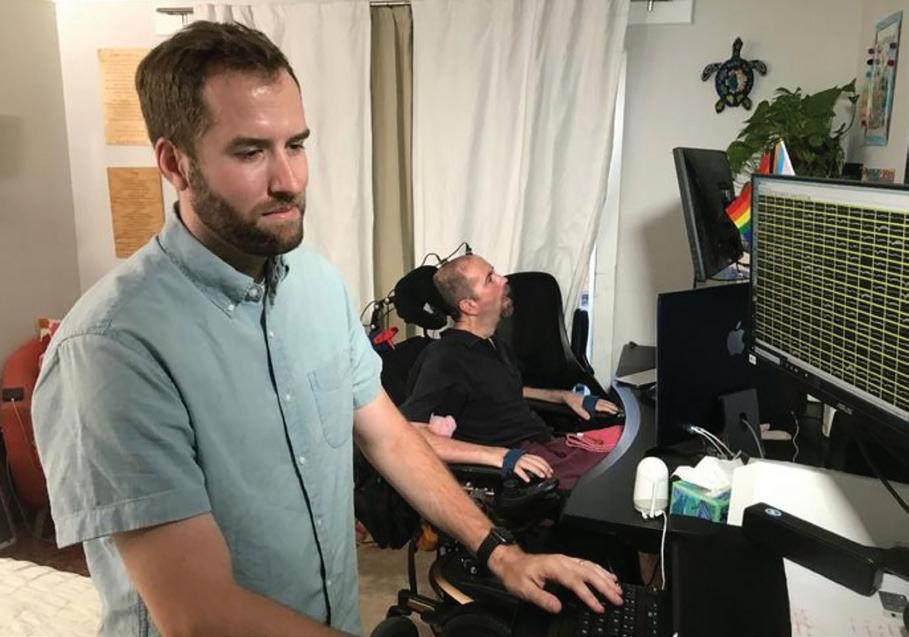
Dr David Brandman, co-principal investigator and assistant professor in the UC Davis Department of Neurological Surgery, explained: “Our BCI technology helped a man with paralysis to communicate with friends, families and caregivers. Our paper demonstrates the most accurate speech neuroprosthesis (device) ever reported.”
Rapid training and expanded vocabulary
One of the most impressive aspects of this new BCI system is its ability to achieve high accuracy with minimal training time.
In the first speech data training session, the system achieved 99.6% word accuracy with a 50-word vocabulary in just 30 minutes. By the second session, the potential vocabulary expanded to 125,000 words, maintaining 90.2% accuracy with only an additional 1.4 hours of training.
Dr Sergey Stavisky, co-director of the UC Davis Neuroprosthetics Lab, noted the emotional impact of the system’s success: “The first time we tried the system, he cried with joy as the words he was trying to say correctly appeared on-screen. We all did.”
internal speech
While the UC Davis study focused on interpreting attempted speech, researchers at the
California Institute of Technology and the Feinstein Institutes for Medical Research have made strides in decoding internal speech –words that are thought but not spoken aloud. Their study, published in Nature Human Behaviour [2], demonstrated for the first time that a computerised brain implant can decode internal speech with minimal training.
The research team, led by Richard Andersen and Sarah Wandelt, implanted a device in the supramarginal gyrus of two individuals with tetraplegia. This brain area is known to be important for representing spoken words. The participants were asked to think about ‘saying’ specific words without speaking or moving, while the BCI measured their brain activity to predict the words being ‘spoken’ internally.
The study revealed varying levels of success between the two participants, with one achieving an average accuracy of 79% and the other 23%. Researchers attributed this discrepancy to differences in the unique patterns of brain activity associated with different words in each participant. Despite these challenges, the findings offer proof-of-concept for a high-performance internal speech BCI. The device’s ability to decode nonsense words suggests that words are represented phonetically in this part of the brain, rather than based on their meanings.
References:
Both studies represent significant advancements in the field of BCIs and offer hope for individuals who have lost the ability to communicate due to paralysis or neurological conditions. As Dr Brandman noted: “This technology is transformative because it provides hope for people who want to speak but can’t. I hope that technology like this speech BCI will help future patients speak with their family and friends.”
While there is still much to learn about decoding internal speech reliably, these findings pave the way for future developments in restoring communication for
those affected by conditions such as ALS, brain injuries, and spinal cord injuries. As research in this field continues to progress, supported by initiatives like the NIH Brain Research Through Advancing Innovative Neurotechnologies (BRAIN) Initiative, we may be moving closer to a future where the ability to communicate using only one’s thoughts becomes a reality for those who need it most.
Watch video:
New brain-computer interface allows man with ALS to ‘speak’ again https://bit.ly/3yR4lA3
1. Card, N. S., Wairagkar, M., Iacobacci, C., et. al. (2024). An Accurate and Rapidly Calibrating Speech Neuroprosthesis.
New England Journal of Medicine, 391, 609-618. https://doi.org/10.1056/NEJMoa2314132
2. Wandelt, S. K., et al. (2024). Representation of internal speech by single neurons in human supramarginal gyrus.
Nature Human Behaviour https://doi.org/10.1038/s41562-024-01867-y
A small NIH-funded trial demonstrates the potential of personalised adaptive deep brain stimulation to significantly improve symptom management in Parkinson’s disease patients.
In a groundbreaking development for Parkinson’s disease (PD) treatment, researchers have successfully tested a self-adjusting brain pacemaker that responds to real-time changes in brain activity. This adaptive deep brain stimulation (aDBS) device has shown remarkable efficacy in managing PD symptoms, outperforming conventional deep brain stimulation (DBS) methods. The study, published in Nature Medicine [1] and funded by the National Institutes of Health (NIH), marks a significant stride towards personalised medicine in neurological disorders.
The challenge of fluctuating symptoms Parkinson’s disease, a progressive neurodegenerative disorder, presents a unique challenge in symptom management due to the fluctuating nature of its manifestations.
Conventional DBS, while effective, delivers a constant level of stimulation that may not always align with the patient’s changing needs throughout the day. This mismatch can lead to suboptimal symptom control and potentially exacerbate side effects.
The new aDBS system addresses this limitation by continuously monitoring brain activity and adjusting stimulation levels accordingly. This dynamic approach allows for a more nuanced and responsive treatment strategy, potentially offering patients greater relief from their most difficult symptoms without compromising other aspects of their condition.
The researchers then implemented the aDBS system alongside the existing DBS therapy. After an initial training period for the aDBS algorithm, participants were sent home for a comparative trial. The study alternated between conventional DBS and aDBS treatments every two to seven days, with participants unaware of which treatment they were receiving at any given time.
The results were striking. aDBS improved each participant’s most troubling symptom by approximately 50% compared to conventional DBS. Notably, three out
The feasibility study, led by Philip Starr, M.D., Ph.D., and colleagues at the University of California, San Francisco, involved four participants already receiving conventional DBS treatment. Each participant identified their most troublesome persistent symptom, which typically included involuntary movements or difficulty initiating movement.
of the four participants were often able to correctly guess when they were receiving aDBS treatment due to noticeable symp tom improvement, despite not being in formed of the treatment schedule.
The mechanics of adaptive stimulation
The aDBS system operates on a closed-loop principle, utilising machine learning algo rithms to interpret brain signals and adjust stimulation parameters in real-time. This approach builds upon previous work by Starr and his team, who in 2018 developed an adaptive DBS system that could adjust based on feedback from the brain itself.
However, the implementation of aDBS in real-world settings presented unforeseen challenges. The researchers discovered that DBS treatment itself significantly altered brain activity, rendering the originally tar geted signal undetectable. This necessitated a computational and data-driven approach to identify alternative signals within the brains of PD patients undergoing conven tional DBS therapy.
Implications for levodopa therapy
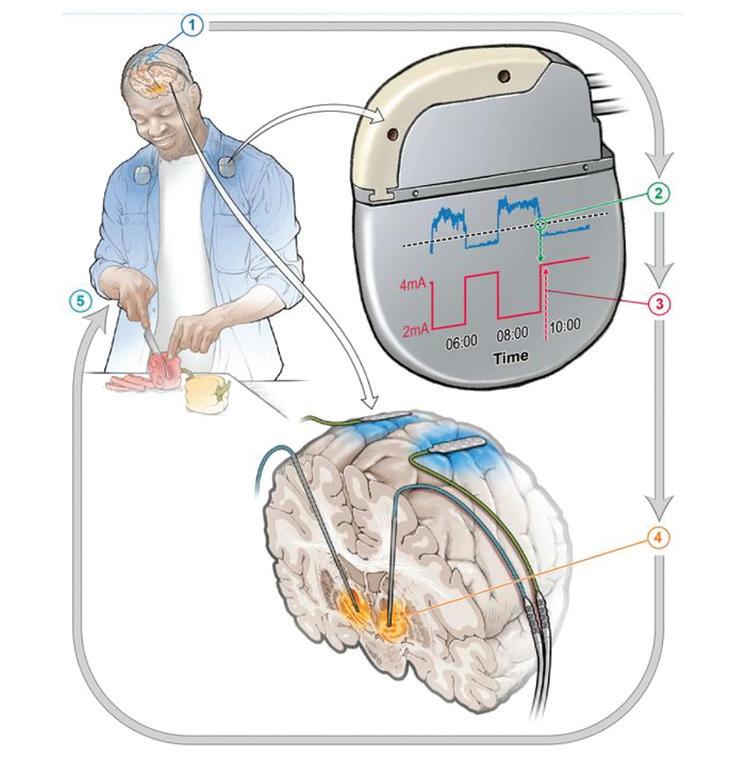
The potential of aDBS extends beyond its direct symptom management capabilities. Conventional PD treatment often involves levodopa, a drug used to replace the dopamine lost due to the disorder. However, levodopa levels in the brain fluctuate, peaking shortly after administration and gradually decreasing as the body metabolises the drug.
aDBS could potentially smooth out these fluctuations by providing increased stimulation when drug levels are high and decreasing stimulation as drug levels wane. This synergistic approach could be particularly beneficial for patients requiring high doses of levodopa, offering a more stable and consistent symptom control throughout the day.
While the results of this study are promising, significant hurdles remain before aDBS can become widely available. The initial setup of the device currently requires considerable input from highly trained clinicians. To address this, researchers envision a future where most of the work would be managed by the device
The implanted adaptive deep brain stimulation device responds to changes in brain signals, adjusts the amount of stimulation required throughout the day, and enables individuals with Parkinson’s Disease to go about their daily activities.
itself, greatly reducing the need for repeat clinic visits for fine-tuning.
Dr Megan Frankowski, program director for NIH’s Brain Research Through Advancing Innovative Neurotechnologies (BRAIN) Initiative, which helped fund the project, emphasised the importance of automation in expanding access to DBS therapy. “If there were a way for a system to find the most optimal settings at the press of a button, that would really increase the availability of this treatment for more people,” she said.
The success of this aDBS trial represents a significant step forward in the field of neuromodulation. By demonstrating the feasibility and efficacy of a truly responsive brain stimulation system, the study opens new avenues for personalised treatment in
Parkinson’s disease and potentially other neurological disorders.
As research in this area continues, the hope is that aDBS technology will evolve to become more autonomous and user-friendly, ultimately leading to wider adoption in clinical settings. This could revolutionise the management of Parkinson’s disease, offering patients a more tailored and effective treatment option that adapts to their individual needs throughout the day.
While larger trials are needed to confirm these initial findings, the potential of aDBS to significantly improve quality of life for individuals living with Parkinson’s disease is undeniable. As we move towards an era of increasingly personalised medicine, adaptive deep brain stimulation stands out as a promising example of how technology and neuroscience can converge to address the complex challenges of neurological disorders.
Reference:
1. Oehrn, C. R., Cernera, S., Hammer, L. H., et al. (2024). Chronic adaptive deep brain stimulation is superior to conventional stimulation in Parkinson’s disease: a blinded randomized feasibility trial. Nature Medicine. https://doi.org/10.1038/s41591-024-03196-z

By Dr Semer Wang Medical Director at The Brain & Performance Centre, a DP World Company
fering cutting-edge assessments and treatments for adults and children. The centre’s holistic approach integrates physical and cognitive training with nutritional coaching and advanced hyperbaric oxygen therapy (HBOT) to treat various neurological conditions, positioning Dubai as
a key destination for brain health.
At the heart of the centre’s treatment program is HBOT, which involves breathing pure oxygen in a pressurized environment. This therapy increases oxygen levels in the blood, promoting cellular healing, reducing inflammation, and enhancing cognitive functions. The Brain & Performance Centre features the world’s most advanced hyperbaric chambers, offering unmatched treatment capabilities. These chambers allow for optimal oxygen delivery, combined with cognitive activation. This is paramount in treating conditions such as stroke, traumatic brain injury (TBI), cognitive decline, and
In addition to its major role in recovering from neurological events, HBOT is central to enhancing brain performance, neuroplasticity, and mental clarity. It plays a key role in the centre’s holistic approach to treating conditions such as long COVID, fibromyalgia, chronic pain, and chronic Lyme disease, focusing on both the physical and neurological aspects of these diseases by healing the brain and body by addressing the root cause of these ailments.
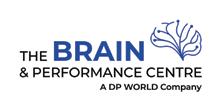
The centre’s innovative approach extends to pediatric care, offering advanced protocols for children suffering from conditions such as: cerebral palsy, traumatic brain injury, stroke and some forms of autism spectrum disorder. By improving neurological function and motor skills, combined with cognitive improvements, the program provides our young patients with a better chance of independence, and improved quality of life.
In addition, our centre takes a revolutionary approach towards aging, treating aging as a manageable condition rather than an inevitable cause for cognitive and physical decline. HBOT can be used to improve the early phases of cognitive decline, enhance memory, improve neuroplasticity, and promote overall brain health. Furthermore, HBOT has been recognized to reverse some age-related biomarkers, such as telomers and senescence cells, allowing individuals to maintain mental and physical acuity as they age.
The Brain & Performance Centre is at the forefront of advanced brain and physical performance, offering comprehensive, state-ofthe-art care that transforms lives.
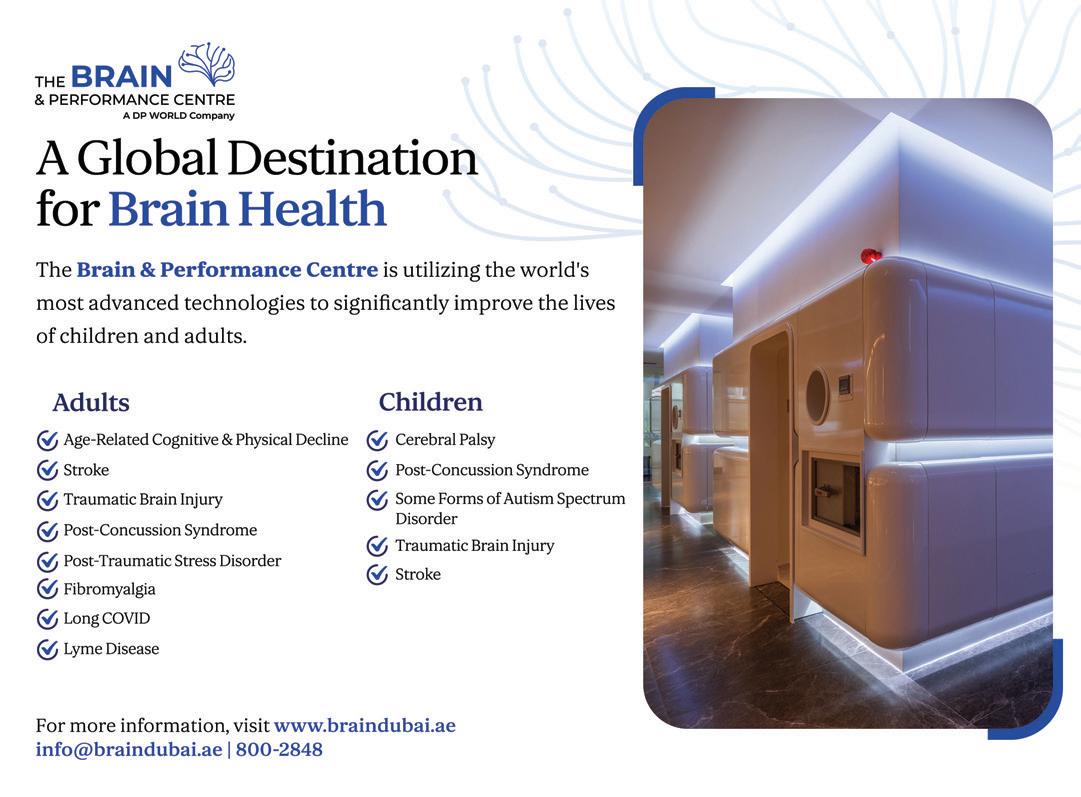
New research from the University of California, Riverside reveals that obesity-induced alterations in the brain may be responsible for reduced testosterone and sperm production in males.
Obesity’s impact on male reproductive health has long been a concern for medical professionals. While the link between excess body weight and reduced fertility is well-established, the underlying mechanisms have remained unclear. Now, a groundbreaking study led by researchers at the University of California, Riverside (UCR) has shed new light on how obesity affects male reproductive function, pinpointing the brain as the primary site of these changes.
The hypothalamus-pituitary-gonadal axis
The study, published in the Journal of Neuroscience [1], focused on the hypothalamuspituitary-gonadal (HPG) axis, a crucial regulatory system for reproductive function. This feedback loop involves the hypothalamus, pituitary gland, and gonads (testes in males), coordinating the production of hormones essential for reproduction.
Professor Djurdjica Coss, lead researcher from UCR’s School of Medicine, explained: “When these neurons in the hypothalamus are not functioning properly, as in obesity, it causes lower hormone levels from the pituitary gland and lower testosterone and sperm production.”
Obesity-induced neuronal changes
To investigate the effects of obesity on the HPG axis, the research team used a mouse model fed a high-fat diet to mimic human obesity. Their findings revealed significant changes in the brains of obese mice, including:
1. Reduced neuronal connections: The team observed fewer synaptic connections between neurons in the hypothalamus that regulate reproduction.
2. Downregulation of receptors: There
was a decrease in the number of receptors responsible for signalling sufficient energy availability and suppressing food intake.
These neuronal alterations may explain why obese individuals struggle to regulate calorie intake effectively. Moreover, the obese mice exhibited lower blood testosterone levels and reduced sperm counts, mirroring the reproductive issues observed in obese human males.
Surprising primary site of impact
Contrary to initial expectations, the study revealed that the brain, rather than the testes or pituitary gland, appears to be the primary site where obesity disrupts normal reproductive function.
“To our surprise, we found the primary site of obesity’s effects is the brain, rather than the testes or pituitary, in disrupting the normal functioning of the neurons that regulate reproduction,” said Prof. Coss.
This finding suggests that obesity-induced changes in the brain’s neuronal networks may be a key factor in the development of reproductive issues in overweight individuals.
While the study was conducted on mice, Prof. Coss emphasised that the same brain mechanisms exist in humans. “We have the same neurons that regulate reproduction and food intake, and the same hormones in the pituitary that regulate testicular function in men, such as testosterone synthesis and sperm production,” she noted.
Given that obesity affects two in five adults in the United States and one in five couples require assisted reproductive technology to conceive, these findings have
significant implications for understanding and addressing obesity-related fertility issues in humans.
The UCR team’s discovery opens up new avenues for research into obesity’s effects on reproductive health. Prof. Coss and her colleagues are now focusing on several key areas:
1. Reversibility of changes: The researchers plan to investigate whether the observed neuronal alterations can be reversed by switching obese mice back to a normal diet and facilitating weight loss.
2. Mechanisms of synaptic changes: Further studies will aim to elucidate the precise mechanisms by which obesity leads to reduced synaptic connections in hypothalamic neurons.
3. Transgenerational effects: Although not yet explored, the team is interested in determining whether these obesity-induced changes can be passed down to offspring.
4. Human studies: Translating these findings to human subjects will be crucial for developing targeted interventions for obesity-related reproductive issues.
Potential for new treatment approaches
The identification of specific neuronal populations and synaptic molecules affected by obesity provides a foundation for developing novel therapeutic approaches. If future research confirms that these changes can be reversed through weight loss, it could offer hope for individuals struggling with obesity-related fertility problems.
Prof. Coss expressed optimism about the potential impact of their findings: “We hope to show that after a certain amount of time following weight loss, the brain is able to reset the body’s food intake, which would help people struggling to lose weight.”
Reference: 1.
et al. (2024). Obesity Alters POMC and Kisspeptin Neuron Cross Talk Leading to Reduced Luteinizing Hormone in Male Mice. The Journal of Neuroscience. https://doi.org/10.1523/JNEUROSCI.0222-24.2024
Mayo Clinic, the top-ranked hospital in the USA, is researching how stem cell therapy can treat neurodegenerative diseases. Mayo is among the first to study whether stem cell therapy might trigger healing for spinal cord injury. Research is ongoing in preclinical models, but it also has advanced from discovery science to early clinical trials. It’s a complex question, because different forms of stem cells can be derived from different biologics within the body. Mayo Clinic is driving the research that seeks new ways to restore form and function for patients with debilitating injuries and diseases.
Spinal cord injury Mayo Clinic researchers found that rats with spinal cord injury have improved movement after applying stem cells. The authors hope this preclinical data will support the eventual development of regenerative therapy for spinal cord healing.
“Spinal cord injury affects many patients, and current treatments are often limited and supportive in nature,” says Mohamad Bydon, M.D., a Mayo Clinic neurosurgeon and senior author of the paper. “This research is an opportunity to impact a significant disease that causes a great burden to so many patients.”
When the spine is injured, the electrical signal it carries from the brain is stopped at the point of injury, and the patient experiences paralysis. Unlike skin or muscle cells, injured cells of the spinal cord, called “neurons”, don’t repair or replace themselves very quickly or at all, especially as the body ages. To see if the healing process could be jump-started, Dr.
Bydon’s team examined if the cells that help regenerate other tissues could help in the spine, as well.
Stem cells are a kind of cellular template. In an embryo, these are the cells that can divide into more stem cells or become other tissues in the body. In adults, stem cells are more limited, but they are also less controversial in terms of ethical use. They can be harvested from bone marrow or fat tissue, and then engineered back into a stem cell-like state and called “mesenchy mal stem cells”. Less invasively, stem cells can be gathered from umbilical cord blood saved after pregnancy. These cells are, as Dr. Bydon and his co-authors write, easier to work with and divide more actively than mesenchymal stem cells collected from bone marrow or fat.
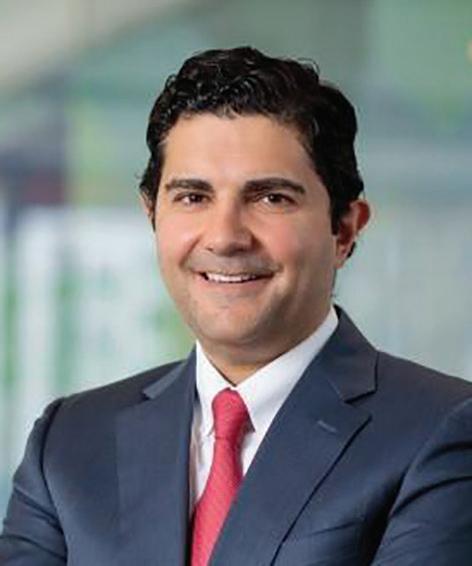
area of unmet need,” says Dr. Bydon. “We have the opportunity and potential to create new paradigms of treatment.”
Best hospital in the world
The team, which is led by Dr. Bydon, used rat umbilical cord stem cells to treat six of the 12 rats in the study one week after spinal cord injury. The rats were evaluated for 14 weeks after injury, and the authors found that the procedure resulted in improved motor function, compared to the control rats.
“Umbilical cord-derived mesenchymal stem cells may have a neuroprotective function,” says Dr. Bydon, citing better healing in the insulation around the nerve cells, smaller injury size, fewer immune cells flocking to the area and reduced scar formation.
In subsequent work, the team plans to clarify the regenerative properties of mesenchymal stem cells to create a targeted therapy for spinal cord healing.
“At Mayo, we focus on the needs of the patient, and in the case of patients with spinal cord injury, there is a significant
Mayo Clinic is the world’s largest integrated, not-for-profit medical group practice. Newsweek magazine ranks Mayo Clinic as the best hospital in the world. Additionally, U.S. News & World Report has ranked it No. 1 in more specialties than any other hospital in the U.S. for seven consecutive years. Mayo Clinic has locations in Rochester, Minnesota, Phoenix, Arizona and Jacksonville, Florida in the United States and a specialty clinic in London, England. • To refer a patient to Mayo Clinic, visit: mayoclinic.org or scan the QR code below.

Thirty-three per cent of the world’s population suffers from a neurological disease and 14% from mental illness. Research in these fields is essential.
There is a growing global concern about the increasing prevalence of mental health issues, which represents a great challenge for health systems. At Cinfa, our main objective is to offer a wide range of products in this therapeutic area.
According to the WHO, in 2019, 1 in 8 people, or 970 million people worldwide, were living with a mental disorder, with anxiety and depression disorders being the most common. In 2020, the number of people living with anxiety and depressive disorders increased significantly due to the Covid-19 pandemic. In addition, there is a high prevalence of mental disorders that affect children and young people. Many of these patients experience disease-related disabilities, decreased life expectancy, stigma, and discrimination.
A mental health policy and plan is essential to coordinate all mental healthrelated services and activities. Any action aimed at removing the stigma around mental health and encouraging people who are suffering in silence to seek help should also be welcomed.
For many mental health disorders, most studies suggest that a therapeutic approach consisting of a combination of medication and psychotherapy is more effective than either treatment method used alone. But of course, this is a decision that the doctor must make based on each patient’s situation.
The complexity of the brain and neurological illness
At the beginning of 2023, the World Health Organization (WHO) indicated that more than 33% of the world’s population already suffers from a neurological disease. Therefore, research in this field is essential, although it must be recognized that research on the brain has been and

continues to be a great challenge due to its extreme complexity.
At Cinfa, we focus on the treatment of peripheral and central neuropathic pain and epilepsy within the therapeutic area dedicated to the Central Nervous System.
In addition, we are committed to inno vation and have an R&D team with more than 100 people dedicated to the develop ment of advanced healthcare solutions.
Global reach with a regional focus Nearly 18 million people in the Middle East suffer from neurological diseases, causing more than 441,000 deaths a year. It is therefore important that collaboration with researchers and medical centres takes place for early detection of these diseases.
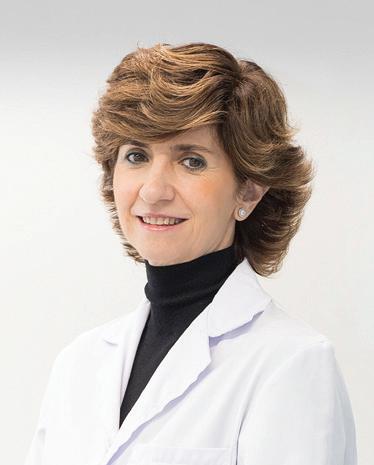
At Cinfa, we collaborate with more than 8,500 medical centres and pharmacies in Saudi Arabia, Qatar, the United Arab Emirates and Kuwait to continue working in this and other areas.
• To learn more about Cinfa, visit: https://www.cinfainternational.com/ cinfa/cinfa-worldwide/
“At Cinfa we focus on the and central neuropathic pain and epilepsy, and we contribute to innovation in this therapeutic area.”
– Dr Alicia López de Ocáriz, Corporate Medical Director at Cinfa Group.


The UK’s leading HealthTech Trade Association, Association of British HealthTech Industries (ABHI), is set to highlight the excellence of UK HealthTech innovation at two premier healthcare trade shows in the Middle East: The Global Health Exhibition in Saudi Arabia, Riyadh from 21-23 October 2024, and Arab Health in Dubai from 27-30 January 2025. These events represent significant opportunities for UK companies to tap into the booming healthcare market in the Middle East and North Africa (MENA) region, where demand for innovative health technologies is rapidly growing.
The MENA region is experiencing an unprecedented growth in its healthcare sector, driven by factors such as rapid population growth, increasing life expectancy, and a rising prevalence of chronic and non-communicable diseases. The healthcare market in this region is expected to grow at a compound annual growth rate (CAGR) of 11.7%, reaching $243.6 billion by 2023, double the growth rate of the
global healthcare market. This burgeoning demand presents a lucrative opportunity for UK HealthTech companies to introduce their innovative solutions to a rapidly expanding market.
The Global Health Exhibition in Riyadh, taking place from 21-23 October 2024, is a key event where ABHI will host the UK Pavilion. This exhibition has earned a reputation as the largest annual healthcare gathering in Saudi Arabia, attracting over 51,000 visitors and 1,000 exhibiting companies. The move to a larger exhibition space in Malham, Riyadh, reflects the event’s growing significance.
Saudi Arabia’s healthcare sector is poised for a digital transformation, driven by ambitious initiatives under Vision 2030 to increase private sector contribution to 50%. This transformation aims to modernise healthcare services, enhance efficiency, and improve the quality of care across the Kingdom. The demand for high-quality medical devices, diagnostics, and digital health technologies presents a
valuable opportunity for UK companies to showcase their expertise and establish new partnerships.
Michelle Michelucci, commenting on the Global Health Exhibition, said: “The Global Health Exhibition, under the patronage of the Saudi Ministry of Health, presents an unparalleled opportunity for UK companies looking to expand their presence in the Kingdom. Building on the success of last year’s event in Riyadh, we are thrilled to once again showcase an exceptional delegation of UK companies. This platform promises abundant opportunities for our businesses to thrive and grow within this dynamic market.”
As the largest healthcare trade show in the Middle East, Arab Health offers an unparalleled platform for UK HealthTech companies to expand their international reach and engage with key decision-makers across the MENA region. The 2024 edition of Arab Health saw participation from over 130,000 professionals from more than 190 countries, with over 3,600 exhibitors generating $2.46
billion in business. The upcoming 2025 edition, marking the show’s 50th anniversary, promises to be even more significant, with UK companies invited to secure their spots at this landmark event.
Michelucci emphasised the importance of this event: “The UK is a key player in the drive to improve patient care around the world through the development and implementation of new technologies. Arab Health offers an exceptional platform for UK HealthTech innovators to showcase their solutions, build international partnerships, and explore new business opportunities in the region.”
For 20 years, the ABHI UK Pavilion has been a prominent feature at Arab Health, underscoring the strong relationship between the UK and UAE. The 2024 show featured 150 leading HealthTech companies from the UK, showcasing groundbreaking solutions and participating in seminars, workshops, and discussions that
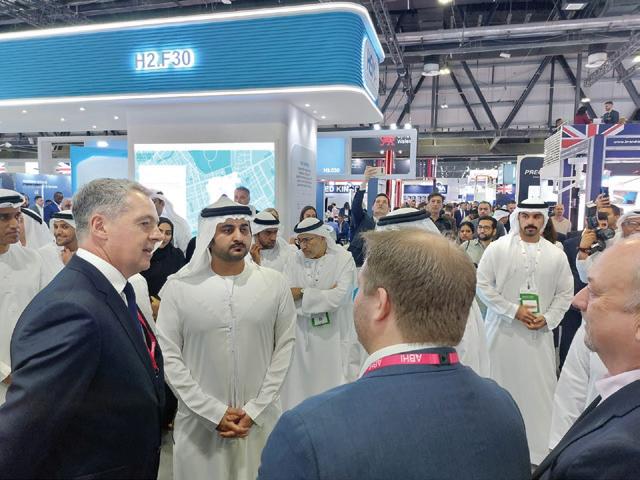
highlighted thought leadership and fostered partnerships.
The ABHI UK Pavilion at Arab Health 2025 will once again bring together the UK’s leading HealthTech small and medium-sized enterprises (SMEs) to showcase their innovative technologies. The Pavilion will feature a diverse array of HealthTech solutions, from state-of-the-art imaging and diagnostic equipment to advancements in surgery, orthopaedics, and wellness.
A highlight of the UK Pavilion will be a
simulated operating theatre, where leading UK hospitals and clinicians will demonstrate surgical procedures using the latest medical technologies. This live demonstration will offer a unique platform for UK clinicians to showcase their skills and for technology providers to engage and educate visitors.
The role of public-private partnerships Investment by governments and increased involvement of the private sector are crucial to meeting the healthcare demands in the MENA region. The UAE and GCC region, in particular, are embracing public-
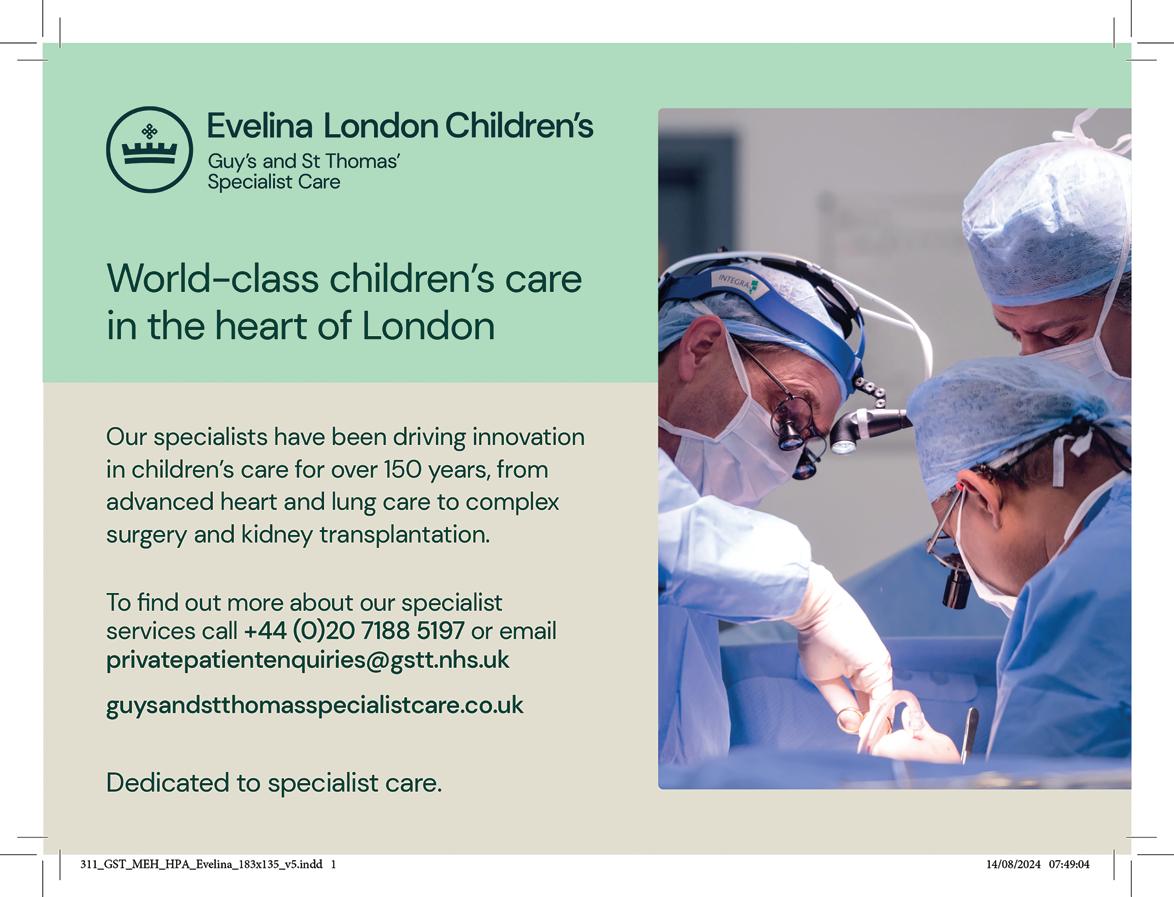
private partnerships to improve healthcare infrastructure. The GCC’s per capita spending on healthcare now surpasses the global average, reflecting the region’s commitment to building world-class healthcare systems.
Dubai’s ambition to become a leading regional hub for medical tourism is evident in its doubling of health tourists in 2021, even amidst pandemic-induced travel restrictions. This focus on medical tourism is driving demand for high-quality healthcare services and innovative HealthTech solutions.
The future of healthcare in the MENA region is being shaped by several key trends: a shift towards holistic and preventative wellness, the need for resilience and agility, the deployment of cuttingedge technologies, strengthening publicprivate partnerships, and managing the
opportunities for companies offering advanced technologies in this space.
Beyond showcasing technology and innovation, the ABHI UK Pavilion emphasises the importance of global partnerships and collaboration. Both the Global Health Exhibition and Arab Health provide platforms for UK companies to forge strategic alliances with local and international partners, fostering a spirit of cooperation that transcends borders. These events also serve as a hub for knowledge exchange, with numerous seminars, workshops, and discussions that allow participants to share insights and best practices.
The ABHI’s commitment to these events highlights the UK’s proactive approach in engaging with the MENA region, ensuring
evolve, such international collaborations will be crucial in addressing the common challenges faced by health sectors globally and improving patient outcomes on a larger scale.
The upcoming healthcare trade shows in the Middle East present significant opportunities for UK HealthTech companies to expand their reach and tap into a booming market. The ABHI UK Pavilion at these events will showcase the best of UK innovation, offering a platform for companies to engage with key decision-makers, build international partnerships, and explore new business opportunities. As the MENA region continues to invest in healthcare infrastructure and embrace digital health solutions, UK companies are well-positioned to contribute to the region’s healthcare transformation. The ABHI’s involvement in these events underscores the
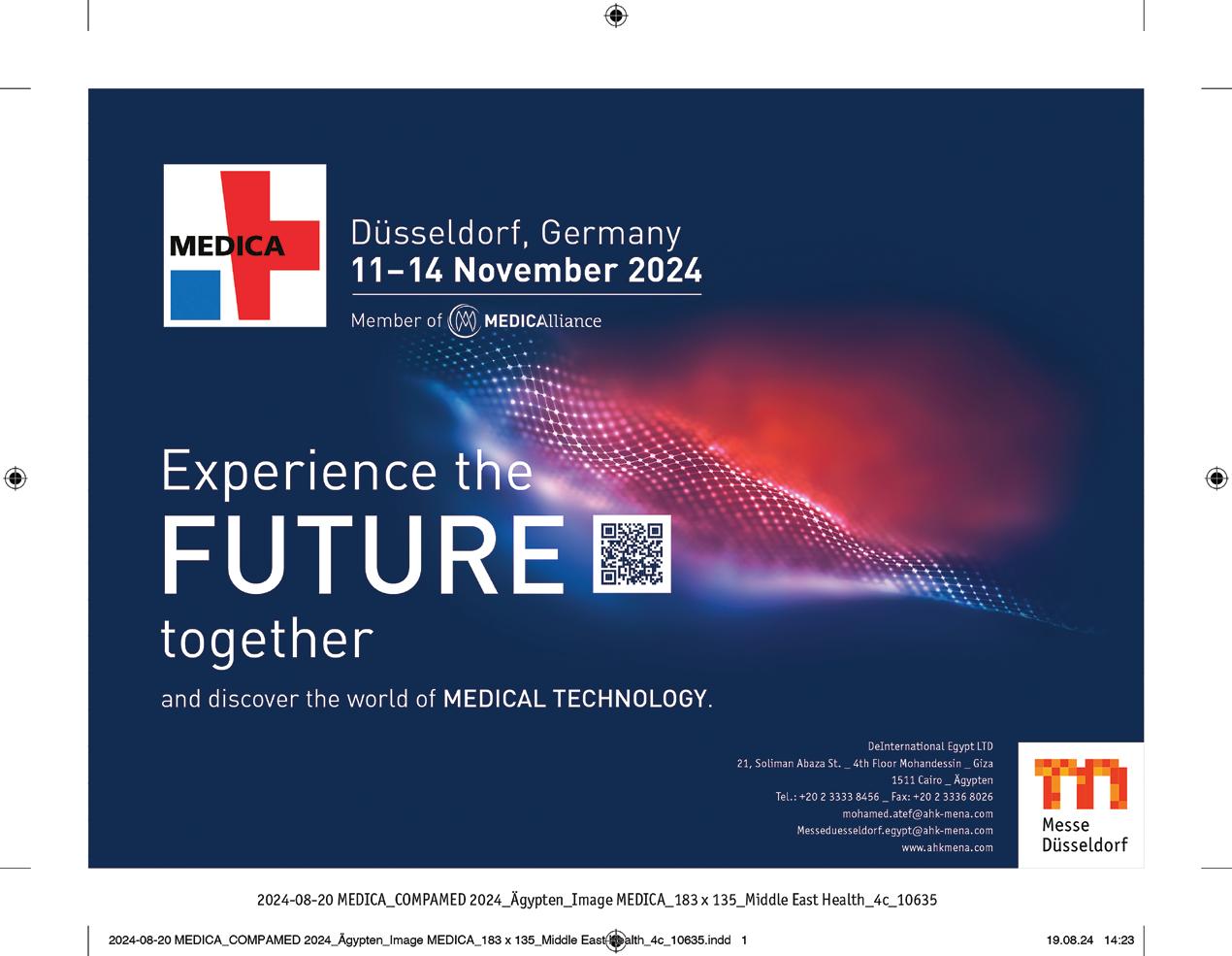

As clinicians, we know that the field of medicine is a constantly evolving landscape, with new research emerging daily that enhances our understanding of diseases and expands the arsenal of drugs available to treat them. For those on the front lines of patient care, this becomes even more challenging. Balancing the need for safe and effective treatment with the unique circumstances of individual patients and the limitations of existing resources is an issue that clinicians are dealing with around the world. Jordan Fulcher explores these challenges and provides some solutions.
The foundation of safe prescribing: Licensing and labelling
The foundation of safe prescribing lies in the licensing and labelling of medications. These regulations ensure that medications are rigorously tested and proven effective for their intended uses. However, the focus of this information is often on the broad strokes of regulatory approval, leaving out the finer details and nuances that are crucial for clinical decision-making. Regulatory approval and labelling primarily focus on approved uses, dosages, and safety warnings, which may not capture the dynamic nature of medical research. Emerging evidence on a drug’s effectiveness for off-label uses remains largely absent. Additionally, the latest prescribing strategies developed through real-world clinical experience may not be reflected in these documents, leaving clinicians out of the loop on potentially life-saving advancements.
The limitations of current resources for clinicians
National formularies, which are commonly relied upon by clinicians for prescribing information, frequently draw heavily from these licensing documents. While they provide essential general information about a medication, they fall short in several key areas.
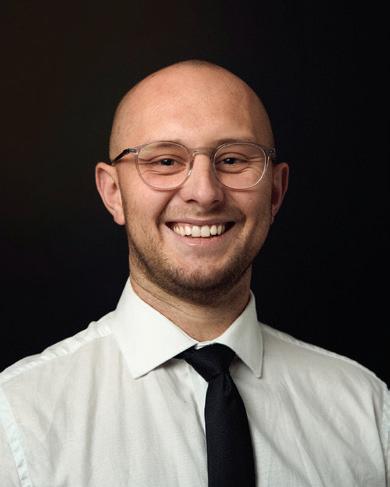
• Limited scope of information information available in formularies and labels often adheres to a one-size-fits-all ap proach. Labels cater to a broad audience, offering a simplified version of a drug’s interaction with the human body. However, each patient is unique. Factors such as age, weight, existing health conditions, and genetic makeup can significantly impact how a drug behaves within an individual. Limited information can lead to dosage miscalculations, increasing the risk of a medication being, at best, ineffective. At worse, it could cause adverse reactions and patient harm.
• Lack of depth and breadth. Manufacturer labelling often prioritises brevity, omitting detailed information on a drug’s mechanism of action, potential side effects at different dosages, or how the drug interacts with specific foods or supplements. This lack of depth hinders a clinician’s ability to fully understand a medication’s intricacies. Without a thorough understanding of how a drug works, potential side effects may be difficult to anticipate or manage. Similarly, omitting details on the severity and prevalence of adverse reactions at various dosages makes it harder to discuss potential downsides with patients and make truly informed decisions together.
• Drug interactions and adverse reactions: A medication prescribed for one con-
dition might interact poorly with another drug or supplement a patient is taking for a different indication, leading to reduced effectiveness or serious health complications. Whilst labelling and formularies often provide concise lists of interactions, there is a lack of actionable recommendations. Limited information on potential interactions makes it challenging for clinicians to identify these risks and manage them, potentially jeopardizing patient safety. These limitations highlight a clear need: The current resources available to clinicians are insufficient for navigating the complexities of modern medicine. A high-quality, evidence-based solution [1] is needed to empower clinicians to diagnose effectively, prescribe medications with greater precision, and ultimately deliver superior patient care.
More comprehensive resources that seamlessly integrate the latest research findings, such as UpToDate® Lexidrug™[2] drug reference solution and Medi-Span®[3] embedded drug data, enable clinicians to stay informed about the most recent, evidencebased prescribing strategies. Providing patient-specific guidance[4], considering a patient’s medical history, potential drug interactions, and even down to their genetic
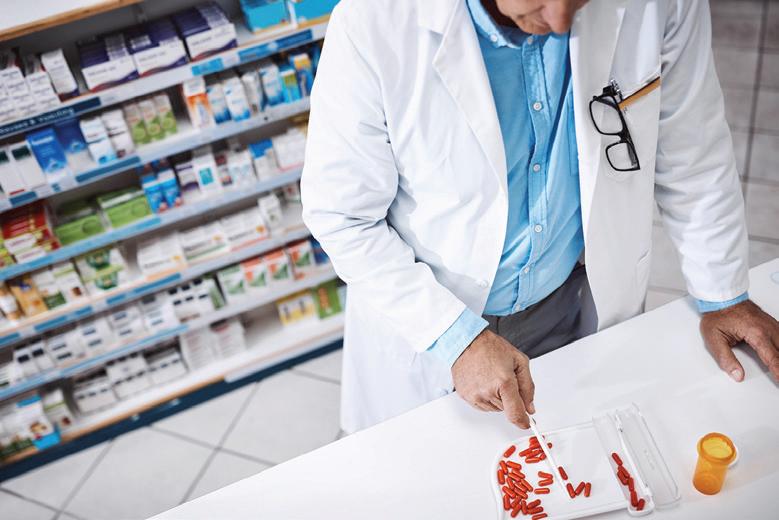
variations[5]. This level of personalised information would significantly reduce the risk of adverse reactions and optimize treatment effectiveness. Providing clinicians access to detailed information allows them to identify and anticipate potential side effects and manage them proactively.
A trusted solution partner backed by trusted evidence and a rigorous editorial review process [6] will not only highlights potential issues with prescriptions and treatments but will also provide clinicians with a clear action plan on how to manage these situations. One clinical resource that covers all stages of the medication process – from diagnosing, to prescribing, to administration and onto monitoring and management – aligns clinicians and clinical teams, providing all with the consistent access to the information that they need, at the right time, and allowing them to find guidance specific to the patient that they are treating.
Streamlining medication prescribing, administration, and monitoring
How could a more personalised medication decision support solution work for you and your clinical teams in the real world?
Step 1: prescribing
Let’s consider the following clinical situation: An elderly patient with a background of epilepsy has been diagnosed with hospital-acquired aspiration pneumonia. The usual local hospital guidelines recommend meropenem for this indication, but how do we adjust this for our specifzic patient at the prescribing stage? Firstly, we consider:
• Do they have any renal impairment[7] associated with their advanced age?
• Is their infection susceptible to me-
ropenem, and how would we test for that?
• What medicines are they taking for their epilepsy that could interact with the treatment?
In this case, the labelling states that the use of meropenem with valproic acid and its derivatives are not recommended, but no practical information is provided to the clinician on how this should be managed in practice. What alternatives can be given?
2: verification
Once a prescribing decision has been safely made, the pharmacist has additional considerations prior to verification.
• How should the treatment be monitored?
• When should this be reviewed?
• How do we step the patient down?
Even when the medication is verified and ready to be administered, the nursing team will have additional questions that need to be answered to ensure safe administration.
• What infusion options do I have for this treatment?
• Can I safely administer this IV medication[8] alongside the others prescribed for my patient, or will I need to set up a new line?
• Is there any administration associated reactions that I need to be aware of?
References:
Without a trusted solution, these various clinicians can end up working from disparate resources, with varying degrees of accuracy. Resources such as UpToDate®, UpToDate Lexidrug, and MediSpan align the highest-quality evidence with patient management recommendations. All members of the care team have access to the answers that they need, in one place.
The role of trusted resources in medication management
The current information provided by labelling and national formularies is not enough for modern medicine. The limitations of existing resources force clinicians to balance adhering to regulations with providing the best possible care for their patients. A more comprehensive solution that integrates the latest research, offers patient-specific guidance, and provides indepth drug information is essential. Empowering clinicians with such a tool would not only streamline the prescribing process but also lead to safer, more effective, and ultimately better patient care.
• Learn more about Wolters Kluwer medication decision support solutions: www.wolterskluwer.com/en/solutions/ uptodate/drug-decision-support.
1. www.wolterskluwer.com/en/solutions/uptodate/drug-decision-support
2. www.wolterskluwer.com/en/solutions/uptodate/enterprise/lexidrug
3. www.wolterskluwer.com/en/solutions/medi-span/medi-span-around-the-world
4. www.wolterskluwer.com/en/expert-insights/why-its-important-to-adjust-drug-dosing-for-patient-specific-factors
5. www.wolterskluwer.com/en/expert-insights/pharmacogenomics-balancing-optimism-challenges
6. www.wolterskluwer.com/en/solutions/uptodate/about/editorial-process
7. www.wolterskluwer.com/en/expert-insights/optimizing-renal-dosing-to-improve-patient-outcomes
8. www.wolterskluwer.com/en/expert-insights/iv-compatibility-challenges-best-practices-and-the-route-ahead

New research suggests that engaging in creative activities could have significant benefits for public mental health, rivalling the positive impact of employment.
A study published in Frontiers in Public Health on 16 August 2024 has revealed that participation in arts and crafts activities is associated with improved mental wellbeing, potentially offering a novel approach to public health interventions. The research, conducted by scientists at Anglia Ruskin University, analysed data from over 7,000 participants in the UK’s annual Taking Part survey.
The impact of creative engagement Dr Helen Keyes, lead author of the study, emphasised the substantial effect of creative activities on individuals’ sense of life’s worth. “Crafting and other artistic activities showed a meaningful effect in predicting people’s sense that their life is worthwhile,” Dr Keyes explained. “Indeed, the impact of crafting was bigger than the impact of being in employment.”
This finding is particularly significant given the challenges to public mental health in the wake of the COVID-19 pandemic. The research suggests that promoting access to artistic activities could provide a cost-effective and widely accessible means of improving population-level wellbeing.
The study analysed responses from 7,182 participants in the Taking Part survey, which evaluates public engagement with cultural, digital, and sporting activities. This broad sample allowed researchers to investigate the impact of creative arts generally, rather than focusing on specific crafts.
Importantly, the researchers controlled for sociodemographic variables known
to affect wellbeing, including gender, age group, health, employment status, and level of deprivation. This approach helped to isolate the specific impact of arts and crafts engagement on mental health outcomes.
Participants were asked to rate their feelings of happiness, anxiety, and life satisfaction, as well as their sense of life’s worthwhileness. They were also questioned about their experiences of loneliness. The study found that 37.4% of respondents had participated in at least one craft activity over the previous 12 months.
The results revealed that individuals who engaged in arts and crafts reported higher levels of happiness and life satisfaction, as well as a stronger sense that life is worthwhile. Notably, the boost to respondents’ sense of life’s worthwhileness was comparable to the positive impact of being in employment.
However, the study did not find a significant relationship between arts and crafts engagement and levels of loneliness. The researchers speculate that this may be due to the solitary nature of some craft activities, suggesting that further research is needed to explore the social aspects of creative pursuits.
While the observed effects were small, their magnitude was similar to that of sociodemographic variables, which are typically much harder to influence. This suggests that leveraging the positive effects of artistic activities could offer a significant
opportunity to improve public wellbeing.
Dr Keyes proposed that “Governments and national health services might consider funding and promoting crafting, or even socially prescribing these activities for at-risk populations, as part of a promotion and prevention approach to wellbeing and mental health.”
The accessibility and affordability of many arts and crafts activities make them particularly attractive as potential public health interventions. Unlike some wellness strategies that may be cost-prohibitive or require specialised equipment, creative pursuits often have low barriers to entry.
The researchers cautioned that their study is correlational in nature, and further research will be required to establish causation. Dr Keyes acknowledged this limitation: “We can’t know for certain whether crafting is directly causing this increase in wellbeing. The next step would be to carry out an experimental study where we measure people’s wellbeing before and after significant periods of crafting.”
Such experimental studies could provide more robust evidence for the direct impact of arts and crafts on mental health outcomes. This could, in turn, inform the development of targeted interventions and public health policies.
Reference: Keyes, H., et al. (2024). Creating arts and crafting positively predicts subjective wellbeing. Frontiers in Public Health, 12. https://doi.org/10.3389/fpubh.2024.1417997
In recent years, South Korea has emerged as a significant player in the global life sciences, biotechnology, and pharmaceutical industries. A group of innovative companies from this East Asian nation is making substantial strides in areas ranging from novel drug development to cutting-edge medical devices. These firms are leveraging South Korea’s robust research infrastructure, highly skilled workforce, and government support to push the boundaries of scientific discovery and therapeutic interventions. Their collective efforts span a diverse array of fields, including oncology, regenerative medicine, and bioinformatics, contributing to the advancement of global healthcare solutions and positioning South Korea as a burgeoning hub for biomedical innovation.
Founded in 2017 in South Korea by a paediatric neurologist, Astrogen specializes in developing small molecule-based treatments for neurological disorders. Our company specializes in clinical trials, electrophysiological assessments, evaluations using animal models of neurological diseases, and real-time bloodbrain barrier permeability assessments using microdialysis. This specialization gives us a strong advantage in developing new drugs for neurological disorders.
We currently possess a library of over 700 chemical compounds through our technology that combines molecular modelling and preclinical evaluation techniques.
We have 44 employees, 80% of whom are in R&D, and our core management team consists of professionals with over 20 years of experience in drug development.
Xcell Therapeutics Inc. is a leading company in the field of medium development that launched the world`s first GMP-grade nextgeneration chemically defined medium for human Mesenchymal Stem Cells (MSCs), and aims to grow into a global medium development company that meets the demands of
The company’s flagship pipeline, AST001, is a first-in-class drug targeting core symptoms of autism spectrum disorder. Compared to other global pharmaceutical companies’ drugs that have entered phase 3 clinical trials, AST-001 boasts higher safety, efficacy, and approval potential. Additionally, it has the advantage of being applicable from the age of 2 without any DDI issues. AST-001 demonstrated excellent efficacy and safety in the phase 2 clinical trial and is nearing the completion of phase 3, with statistical results expected in January 2025. Furthermore, AST-001 was recently designated as an orphan drug MFDS (Korean FDA), granting it 11 years of market exclusivity.
Astrogen also has a diverse pipelines targeting various intractable neurological diseases, including Rett syndrome (AST-004), Dravet

syndrome (AST-008), Parkinson’s disease (AST-029), Parkinson’s disease/idiopathic pulmonary fibrosis (AST-030), ADHD (AST031), obstructive sleep apnea ( AST-032), glioblastoma (AST-035), and neurofibromatosis type 1(AST-038). Notably, AST-035, which operates on a molecular glue mechanism, has demonstrated superior efficacy, safety, stability, pharmacokinetics (PK) profile, and bloodbrain barrier (BBB) permeability compared to existing drugs. AST-030 and AST-038 have been successfully out-licensed to China.
Astrogen is actively enhancing its research and development efforts and is seeking strong partnerships in the UAE to establish fruitful collaborations.
• For more information, visit: https://astrogen.co.kr

the advanced regenerative medicine and cellgene therapy (CGT) markets.
We are expanding our pipeline of cellspecific media targeting various cells such as MSCs, exosomes, NK, and T by utilizing “cell-specific media development source technology” (XPorT: Xcell’s platform; opti-
mized media recipe for therapeutics). Xcell Therapeutics successfully launched and commercialized the world`s first GMP-grade chemically defined medium for MSCs, CellCor MSC CD AOF. It followed the launch of CellCor SFD MSC, a serum-free medium for MSCs.
• For more information, visit: https://xcell.media
CEFObio Co., Ltd was founded in September 2011 to conduct research and development for cell-based therapy products and commercialize them. During the start-up period, we focused on establishing basic technologies for developing cell therapy such as 3D cell culture systems, and developing elemental technologies (culture medium, enzymes and culture wear, etc.) for cell therapy.
Since then, CEFObio developed a cell therapy by applying 3D culture technology, a secured original technology. The factory was completed in 2019 and began producing cell therapy for clinical trials in 2020. It also commercialized culture factors, such as culture medium, enzymes,
IMMUNIQUE Inc. is a company specialized in the development of cord blood-derived immune cell therapeutics. Our focus centres on developing regulatory T cell therapeutics to treat intractable diseases including autoim-
and cryosolution for cell-related therapy products by producing them in accordance with ISO13485.
In July 2021, a phase 1 clinical trial of CF-M801 for the rare disease osteonecrosis of the femoral head (ONFH) was approved by the regulatory agency. The trial was completed in June 2023. CF-M801 is a cluster of umbilical cord-derived osteoblast cells. These cells are differentiated from umbilical cord-derived mesenchymal stem cells into osteoblasts.
In addition, we are rapidly expanding the indications for spinal fusion, fractures, etc. We are currently applying for phase 2 clinical trials of CF-M801 for fragility fractures. Non-clinical trials for

spinal fusion have been completed.
In October 2023, the excellence of the cell therapy under development was proven by receiving the New Excellent Technology certification. Additionally, we are developing chondrocyte and immune cell therapies through new pipelines.
CEFObio is a cutting-edge biopharmaceutical technology development company that aims to contribute to the advancement of medical technology through know-how and technological innovation accumulated through many years of stem cell and culture optimization research and development.
• For more information, visit: https://cefobio.com
mune diseases and immunodeficiencyrelated diseases.
With over 24 years of experience in cord blood-related basic and clinical research, along with the commercialization expertise of our parent company, MEDI-
MEDIPOST CO., LTD (KOSDAQ 078160) is leading the global stem cell therapeutics field with the world’s first regulatory-approved allogeneic human Umbilical Cord Blood-derived Mesenchymal Stem Cell (hUCB-MSC) product named CARTISTEM® for patients with knee osteoarthritis (OA), launched in the Korean market in 2012.
Through many years of research on characterization of cord blood-derived stem cells, MEDIPOST’s R&D Institute has been focusing on revealing the cord blood-derived stem cells’ therapeutic effects by understanding their therapeutic mechanisms. Additionally, various routes of cell administration and methods for improving cell manufacturing have been
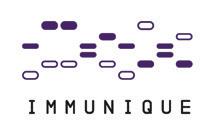
POST, in stem cell therapeutics, IMMUNIQUE is ready to leap forward as a company specialized in immune cell therapeutics.
• For more information, visit: www.immunique.co.kr
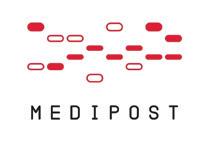
developed by MEDIPOST. MEDIPOST is headquartered in South Korea, with its wholly-owned subsidiaries in the U.S. (MEDIPOST Inc.) and Japan (EVASTEM Co., Ltd.), as well as a stake-holding at a CDMO in Ontario (OmniaBio Inc.), Canada.
• For more information, visit: www.medi-post.co.kr
Cellatoz Therapeutics, Inc. is a biotech company with extensive expertise in translational research and process development. With our state-of-the-art commercialization-ready cGMP grade facility in Korea and unique proprietary cells, we specialize in the development of advanced and innovative cell therapies in the fields of regenerative medicine and immuno-oncology. Our flagship programme, Neuronal Regeneration Promoting Cells (NRPC), involves the differentiation of Schwann cell-like cells from Tonsillar Mesenchymal Stem Cells (T-MSC) for the treatment of peripheral nerve diseases such
as Charco-Marie-Tooth disease (CMT).
Further, we are developing MusculoSkeletal Stem Cells (MSSC), which are IPprotected and possess the remarkable ability to differentiate into various components of the musculoskeletal system. These cells hold promise for regenerating cartilage and treating conditions such as sarcopenia and compound fractures. Our focus also extends to modifying the immune profile of patients to effectively treat solid tumours like glioblastoma (GBM) and recurrent ovarian cancer. We achieve this through gene modification in immune cells and combination therapy with existing drugs.
Collaboration is at the core of our ap-
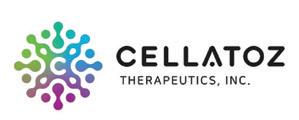
proach, and we work closely with major medical schools and hospitals in Korea, including Seoul National University Hospital, Samsung Medical Center, and Ewha Medical Center.
Seeking partnerships
We are actively seeking partnerships in North America, Europe, and Japan to expand our reach and impact. Overall, we are committed to advancing the field of cell therapy and making a significant contribution to improving patient outcomes worldwide.
• For more information, visit: https://cellatozrx.com
PAEAN Biotechnology (PAEAN) is a clinical-stage biotech company located in Korea focusing on the development and commercialization of mitochondria as therapeutic agents to fulfil unmet medical needs. PAEAN has been developing novel technologies for mitochondria production and formulation to keep the isolated mitochondria stable.
PAEAN published six mitochondriarelated papers and has a broad IP portfolio to secure its mitochondria-based
technologies and products.
• 15 registered Korean patents with 11 registered overseas patents
• 18 pending Korean patents with 16 PCT application
PAEAN’s main product, MitoTherapy, is an allogeneic mitochondria derived from cultured stem cells targeting several diseases: Polymyositis/Dermatomyositis (PM/DM), Parkinson’s Disease, hearing loss, ophthalmic diseases, etc.
The first pipeline candidate, PN-101

for PM/DM treatment received IND approval from MFDS (KFDA) in June 2021. It marked the first allogeneic MitoTherapy product candidate in the world approved by the regulatory body. The Phase 1/2a clinical study to demonstrate the safety and efficacy of PN-101 was completed in Q4 2023 and Phase 2b IND application is scheduled for Q4 this year.
• For more information, visit: https://www.paeanbio.com
Founded in December 2017, INIBIO has rapidly emerged as a trailblazer in the biopharmaceutical industry. With a young and dynamic team boasting an average age of 31.5 years, the company has achieved significant milestones in a remarkably short period. INIBIO’s swift progress underscores its commitment to innovation and excellence in biopharmaceutical development.
One of INIBIO’s early achievements was the completion of its own cGMP-
compliant factory within four years of its establishment. This state-of-the-art facility enabled the company to manufacture its first product, a botulinum toxin type A injection, which received Korean product approval. This achievement laid a strong foundation for INIBIO’s future growth and product offerings.
INIBIO is quickly expanding into global markets based on high-quality products and localization strategies. Building on this foundation, INIBIO is dedicated to

continuous research and development to create patient-friendly and efficient products. The company aims not only to introduce new products but also to advance its proprietary technologies. By investing in the development of a variety of products, INIBIO seeks to enhance patient care and establish itself as a leader in biopharmaceutical innovation.
• For more information, visit: http://www.inibio.com/
K-BioCELF Inc., was established in March 2019, as a Bio Venture company whose main businesses are the development of technology-based Automated Bioprocess Robotic Systems, in vitro diagnostics, and new drugs, based on core technology.
K-BioCELF pioneers advanced bioprocess automation through products such as the CELF™ System for advanced biopharmaceutical automatic manufacturing devices and the CELB ACE™ System for in vitro diagnostic medical devices.
Major products include CELF™ (Automated Cell Culture System), CELB ACE™ System (Liquid Biopsy System, IVD), CELB™ SEP-STD (Automated Blood Separation System), CELP™ (Artificial Skin Model Production System), CELH™ DDR-SP (Reagent Dispensing System), CELH™ DST (Automated Microbial Inoculation System), and in vitro diagnostic kits. These products cover a wide spectrum of biotechnology and medical applications. By partnering with government agencies, we’re developing prototypes for bioprocess

automation equipment, and contributing to national healthcare initiatives. We’re scaling up production to meet the demand for biopharmaceuticals, improving accessibility and quality of life for patients worldwide.
Through our initiatives, we aim to lead the healthcare revolution and leverage automation to improve the efficiency and effectiveness of diagnosis and treatment.
• For more information, visit: www.k-biocelf.com
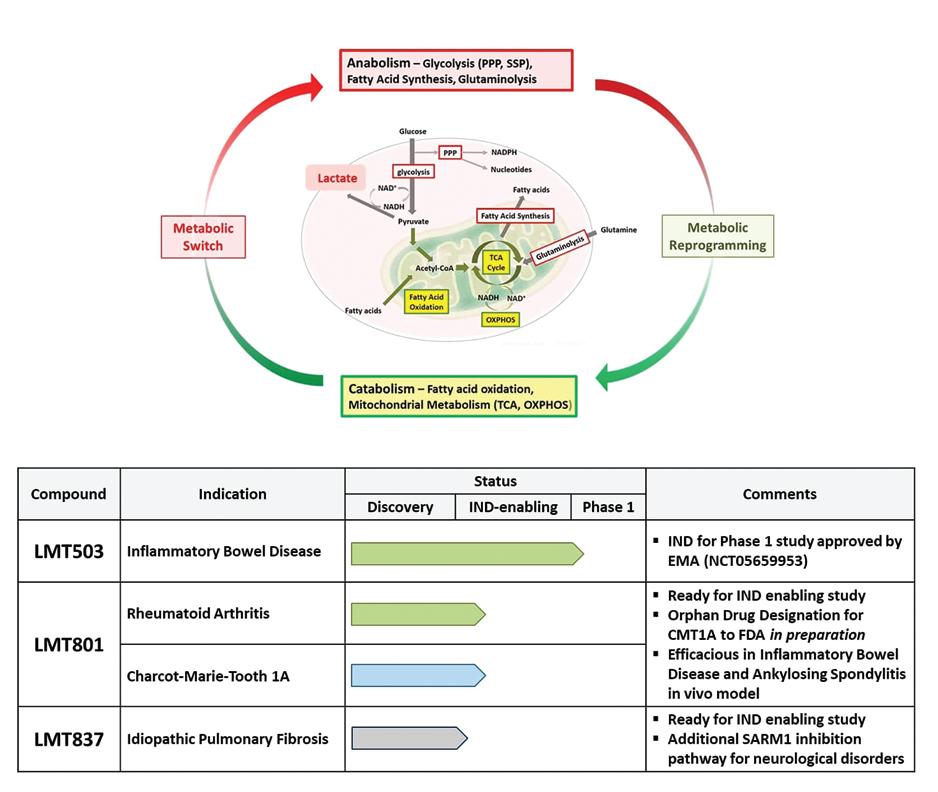
Lmito Therapeutics Inc. is an innovationdriven biotech company with a novel therapy developed through the emerging concept of “metabolic reprogramming” –converting anabolic metabolism to cata-
MedySapiens Inc. is at the clinical forefront of providing testing and analysis solutions for rare diseases in newborns, with the mission and vision of “providing opportunities for a healthy life through fast and accurate diagnostic technology for rare diseases”.
Our Bio-IT fusion technologies provide optimal solutions and services as below:
• Diagnostic panel/kit capable of si-
bolic metabolism in the various microenvironments.
The company has an improved process for robust IND generation platform technology, creating novel and effective therapies for mul-
multaneously testing 265 genes that cause over 220 rare diseases
• MedyCVi® is an AI-driven diagnostic S/W that identifies and evaluates genetic variants associated with rare genetic diseases
We outperform in the following areas:
• Optimized experimental protocol of minimized blood volume requirement, especially for sick newborns in the NICU
tiple applications in various in vivo models of autoimmune disorders, fibrotic diseases, cancers, and neurological disorders.
• For more information, visit: https://www.lmito.com

Reduced TAT, turn-around time (less than 3 days)
• Improved accuracy & specificity through AI-based assessment of genetic variants
• AI solution provides clinicians with speed & genomic counselors’ level of support
• For more information, visit: https://www.medysapiens.com/en
Youth Bio Global was established in August 2017 with the purpose of providing universal medical services to patients suffering from rare and incurable diseases. We aim to become a leading global healthcare provider that contributes to improving human health and quality of life based on cutting-edge diagnostic and treatment technologies.
Management team
Founder & CEO: JUSTIN (SEUNG HO) YOO / Chief Technology Officer: SANG MO, BAE (Plastic Surgeon/Ph.D)
Seung Ho (Justin) Yoo holds a Ph.D. (Medicine) and an MPH from Seoul National University. With a diverse career spanning various prestigious roles, including serving as an evaluator of the Advanced Regenerative Medicine Clinical Research Support Project and an Adjunct Professor at Dongguk University’s Biomedical Engineering Department since 2017. Additionally, he has been involved in multiple associations and committees related to healthcare and regulatory affairs. Dr. Yoo has received numerous awards for his contributions to the field, including recognition from government agencies and healthcare institutions. Moreover, he holds over 10 patents and has authored or co-authored over 10 papers/abstracts.
Financing
• Total Investment: US$5 million (Including Grants)
• Common Stock: 100% (as of Jul.’24)
- CEO has about 76% of Stock
- Angel investors ONLY
Seeking first VC investment
• Round: Series A (Pre A)
• Fund Raising: A bout US$3-5 million
• Valuation: About US$20 million
CELLeBRAIN is a start-up company developing “Cell & Gene Therapies” to address challenging medical conditions. Our proprietary platform technologies employ mesenchymal stem cells (MSCs) engineered to express diverse therapeutic genes to treat sold cancers and chronic fibrotic diseases. Our allogeneic gene & cell therapy products are formulated as off-the
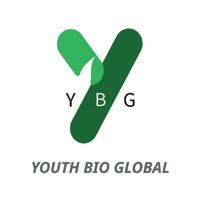
Use of funds
• 65% product development (CMO & Clinical)
• 11% Marketing/Sales
• 20% Operation/Inventory
• 2% Existing debt, 2% Legal/Other
Patents
More than 30+ patents registered or applied.
The business
Short-term advantages include diversification of business by expanding into various ischemic diseases such as myocardial infarction, stroke, and retinopathy, starting with the development of vascular stem cell therapies targeting the diabetic foot indication (designated as a fast track). The company plans to target the total wound care and vascular stem cell market through the sale of stem cell culture medium and wound dressings based on their patented technology. Then, they plan to expand their business and increase their market share by developing and conducting clinical trials, obtaining product approvals, and licensing out for some indications. Based on this excellent vascular stem cell technology, they expect to accelerate their growth rate by conducting R&D with high expandability, such as stem cell therapies and combination products, etc.
Financial performance Projections
• For more information, visit: www.linkedin.com/company/youth-bio-global

shelf, frozen form to meet the high demand in the global market with substantial quantities of doses. Our therapeutic products have met the rigorous Chemistry, Manufacturing, and Controls (CMC) requirements of the Korean FDA and received clinical trial approval after demonstrating its safety and efficacy through non-clinical GLP studies.
Our therapeutic cells provide innovative modalities that combine the benefits of gene therapy and stem cell therapy, while overcoming the limitations of both. We are currently in the process of raising Series B funding and are seeking co-development partners and strategic investors for an IPO.
• For more information, visit: https://cellebrain.com
SML Biopharm Co., Ltd. is an innovative company leading the research and development of mRNA vaccines and therapeutics. Established in 2021, SML Biopharm is developing next-generation cancer vaccines and various disease treatments by combining cutting-edge mRNA platforms with advanced LNP drug delivery systems, leveraging mRNA technology that gained significant attention through COVID-19.
Core technologies
Our linear mRNA platform optimizes 3’ UTR and poly(A) tail to enhance mRNA stability and protein expression, making it ideal for vaccines and therapeutics.
SML Biopharm is developing new drug pipelines using immune and protein expression approaches and advancing a next-generation mRNA platform for better stability and effectiveness. We also independently synthesize and develop lipid nanoparticles (LNPs) for efficient mRNA delivery. With our innovative mRNA and LNP technologies, we drive effective R&D and rapid achievements.
Personalized cancer vaccine
Traditional cancer treatments typically involve administering the same type of therapy to all patients regardless of their unique biomarkers, resulting in varying levels of


effectiveness. However, personalized cancer vaccines represent a significant advancement. By analyzing the tumour specific neoantigen information from each patient and delivering it, these vaccines offer tailored treatments, thereby enhancing their effectiveness for each individual.
SML’s cancer vaccine
SML Biopharm is developing various cancer vaccines using our core technology. Our cancer vaccines work by delivering information about cancer-causing antigens to the body via mRNA-LNP, enabling the immune system to recognize and eliminate these antigens. Currently, SML Biopharm is developing therapeutic vaccines for cervical cancer caused by infection of human
papillomavirus (HPV) and has shown effective anti-cancer efficacy in mice.
Additionally, SML Biopharm is conducting research on next-generation personalized cancer vaccines. We analyzed the genes of healthy mice and mice with colon cancer to predict neoantigens, then administered a vaccine using our mRNA-LNP technology to the cancer-affected mice, resulting in effective anti-cancer efficacy. Moving forward, we plan to develop personalized cancer vaccines for human patients. Additionally, we aim to expand the application of our mRNA-LNP technology to treat various diseases, including rare diseases. Through these efforts, we are committed to working towards a healthier future for people. • For more information, visit: www.smlbiopharm.com

KHIDI strives to provide a variety of opportunities to collaborate with global pharmaceutical companies, including pitching, partnering, and more. KHIDI, along with the Embassy of the Republic of Korea in the UAE and the Abu Dhabi Stem Cell Center (ADSCC), will host the “Medical Korea in UAE 2024 – Innovation and Collabo-
ration: New Horizons in Biohealth” on September 25, 2024 at the Dusit Thani Hotel in Abu Dhabi, UAE.
This is a one-day programme to share current and emerging therapeutics in advanced regenerative medicine, a promising next-generation technology.
In particular, Cell & Gene Therapy (CGT) is expected to open a new era in the bio and pharmaceutical markets as a cutting edge and innovative direction to address unmet medical needs with personalized treatment. Those interested in
the research, investment, and other business collaborations in advanced regenerative medicine are welcome to attend and meet 14 companies from Korea to witness the latest trends and their innovative technologies, especially the future of CGT. In addition, Korean companies will showcase more of their technologies and products at the exhibition booths, which will lead to the future collaborations.
Please do not miss this opportunity to open a new era in CGT!
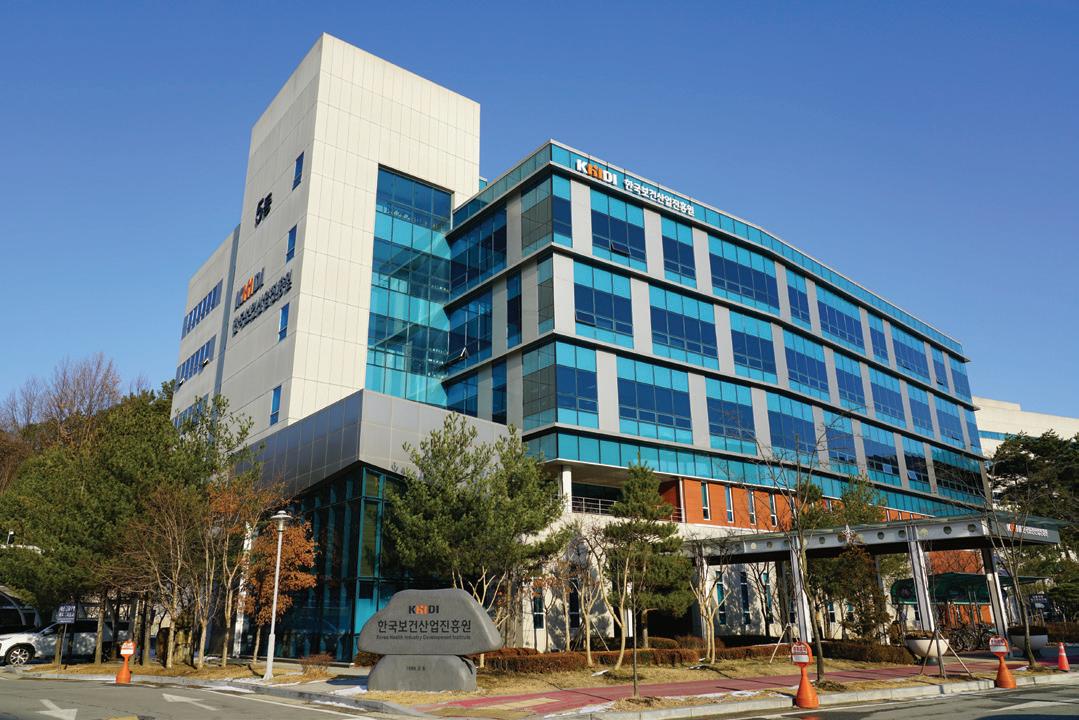
The Korea Health Industry Development Institute (KHIDI) is a government-affil iated organization, under the Ministry of Health and Welfare of Korea. KHIDI carries out national affairs on the goals of fostering the domestic health indus try, strengthening its international com petitiveness, and consequently improving people’s quality of life in order to con tribute to the advancement of Korea as a global bio and digital health hub.
A consensus on the importance of the health industry has formed to build a safe and healthy society against the health risks derived from emerging infectious diseases and a super-aged society. To foster the health industry for the healthy future of our families and neighbours — this is the role and calling of KHIDI.
KHIDI supports for Korea biopharma globalization

In line with the industry’s increased globalization move, KHIDI support the domestic biopharma industry through various ways from consulting services to networking opportunities with global key stakeholders.
The on-site/online consulting with global pharmaceutical experts
KHIDI provides consulting services to help enter the global market with Global Pharmaceutical Key Opinion Leaders
(GPKOLs) and global pharmaceutical experts. It provides customized information on drug development sectors such as R&D, clinical trials, regulatory affairs (RA), business development (BD), project management (PM), and Good Manufactuing Practices (GMP). In doing so, KHIDI supports companies to build innovative new drug development strategies and access global markets.
Support global collaboration for open innovation
KHIDI strives to provide a variety of opportunities to collaborate with global pharmaceutical companies, including pitching, partnering, and more. We invite various global pharmaceutical companies to share the latest trends and status of global open innovation with Korean companies and provide the lat-
est information, such as collaboration strategies, at the Global Open Innovation Week event. In addition, we support participation in major overseas exhibitions for futher collaborations in global markets.
Support global market entry for promising Korean biopharma companies
As of September 2024, KHIDI provides 30 Korean companies work spaces at the Cambridge Innovation Center (CIC) in the Boston biocluster in the U.S.. It not only provides office space at the CIC, but also supports networking for entry into the U.S. market. It is also enabling consultations with U.S. experts on setting up companies, progressing clinical trials and regulatory reviews and approvals, as well as out-licensing deals.
• For more information, visit: https://www.khidi.or.kr/eps






